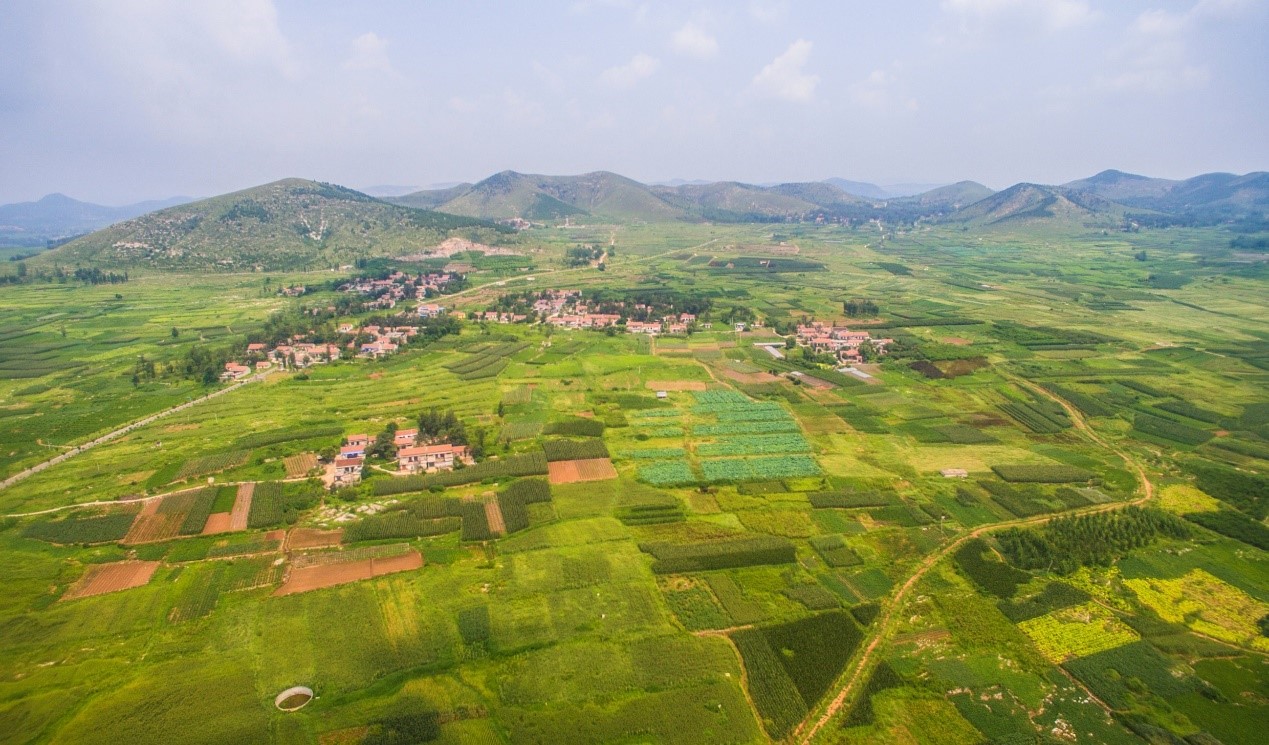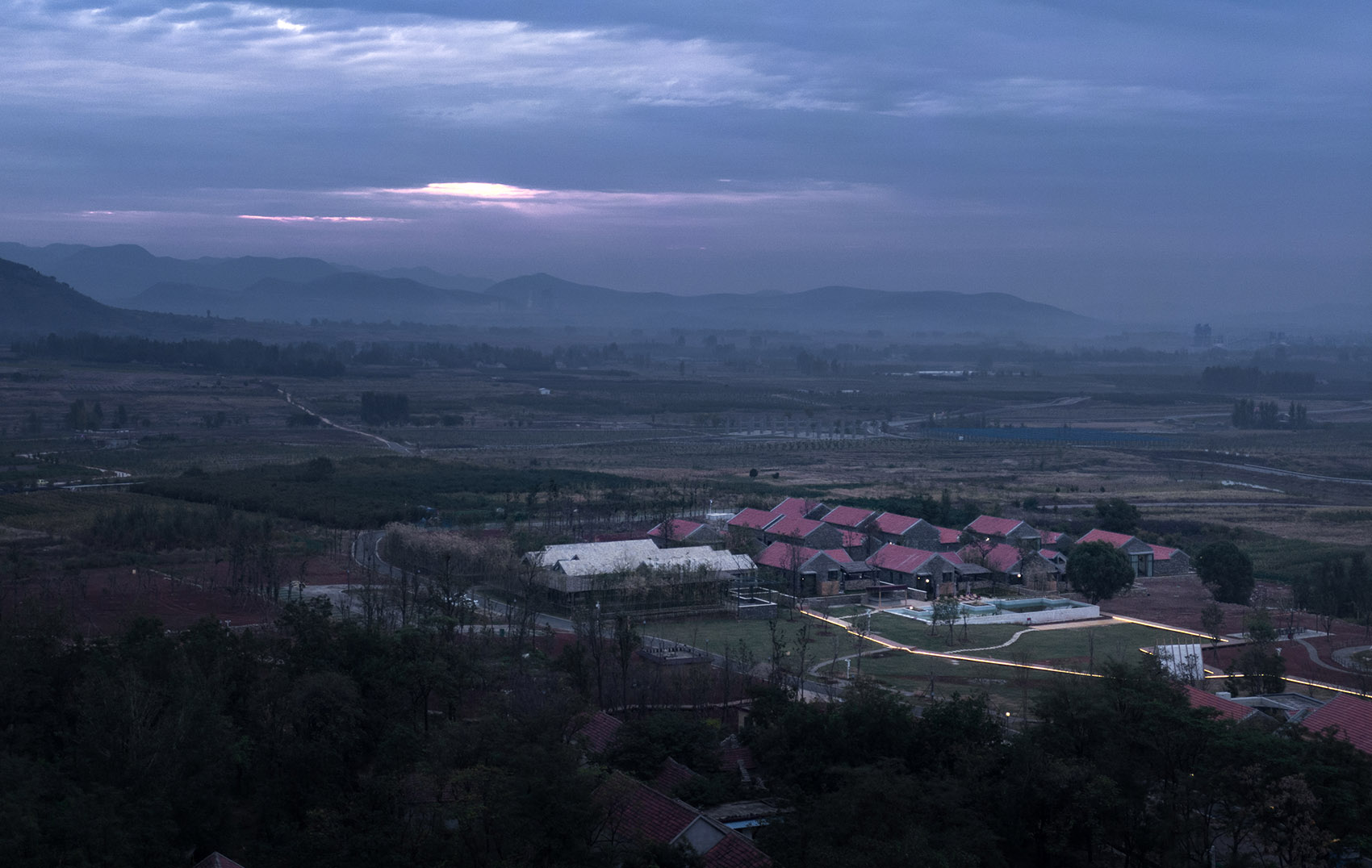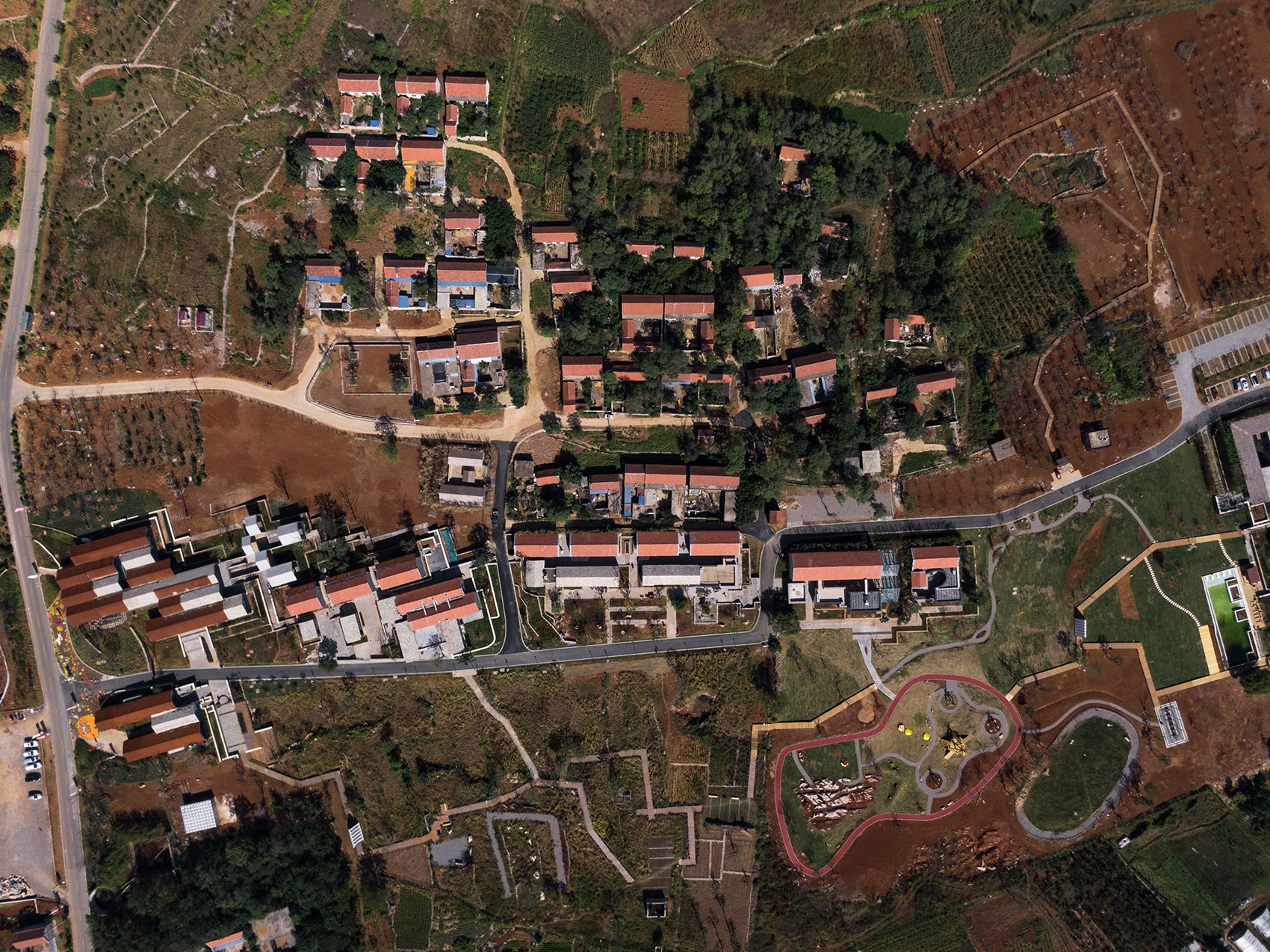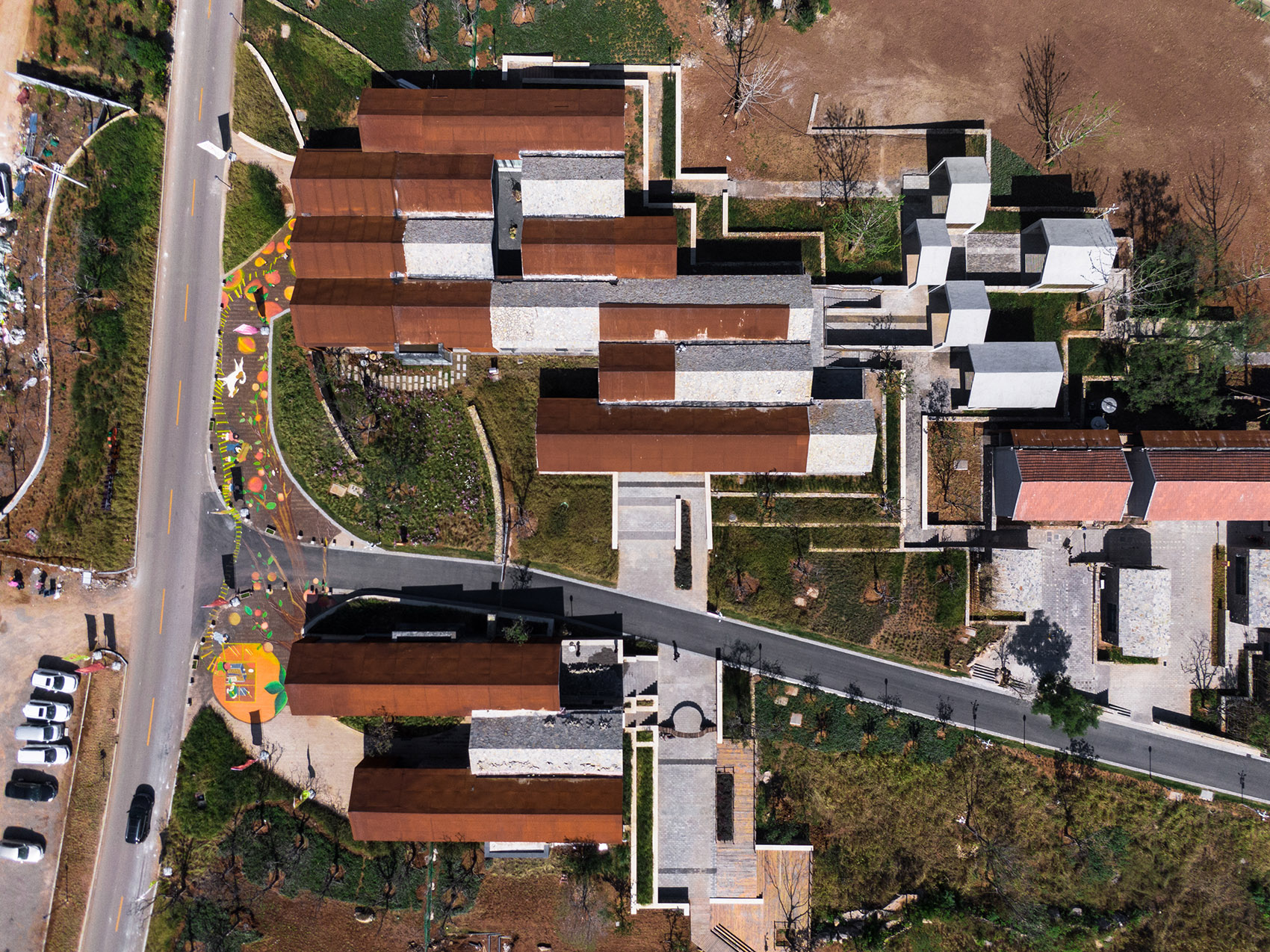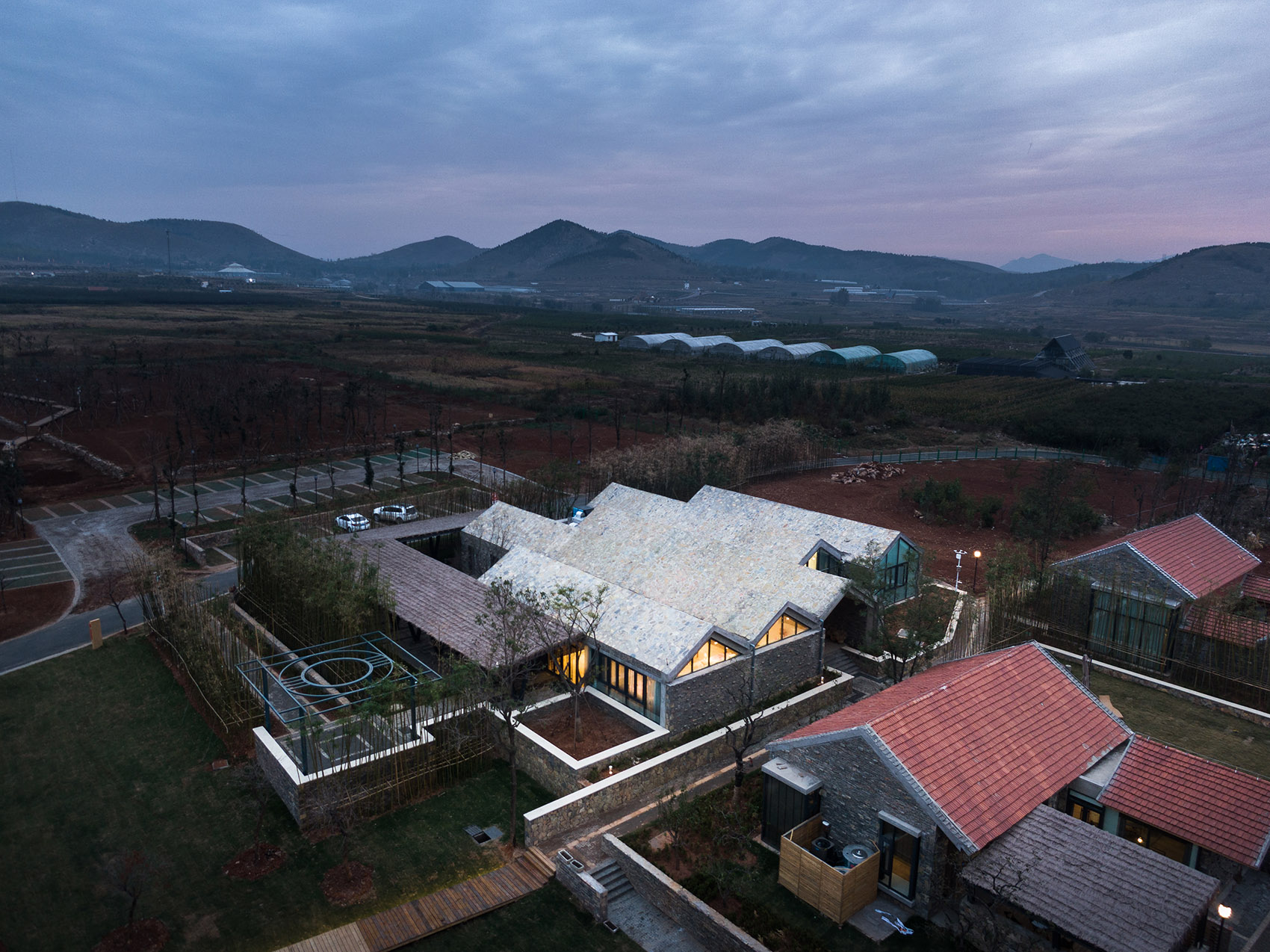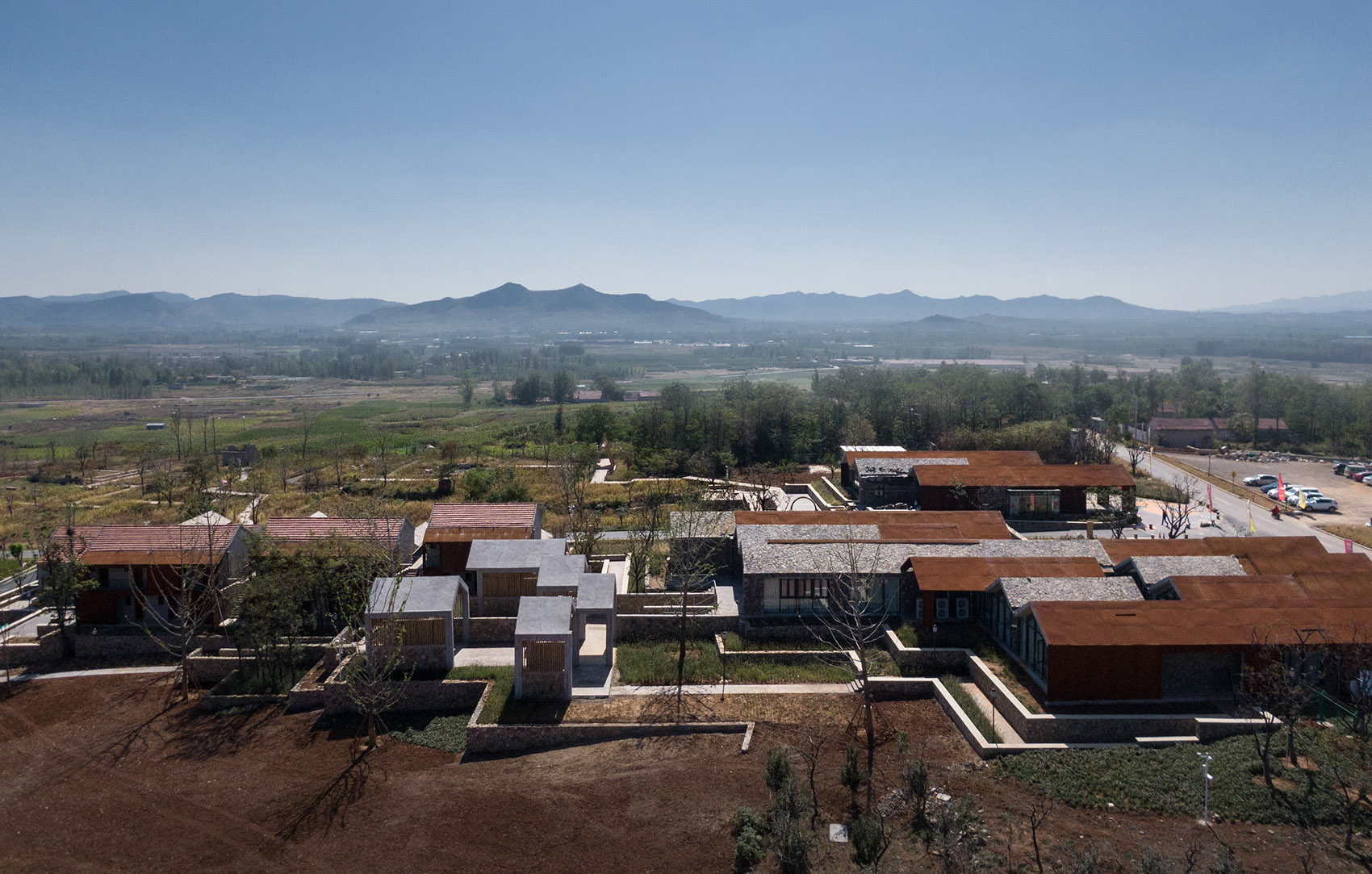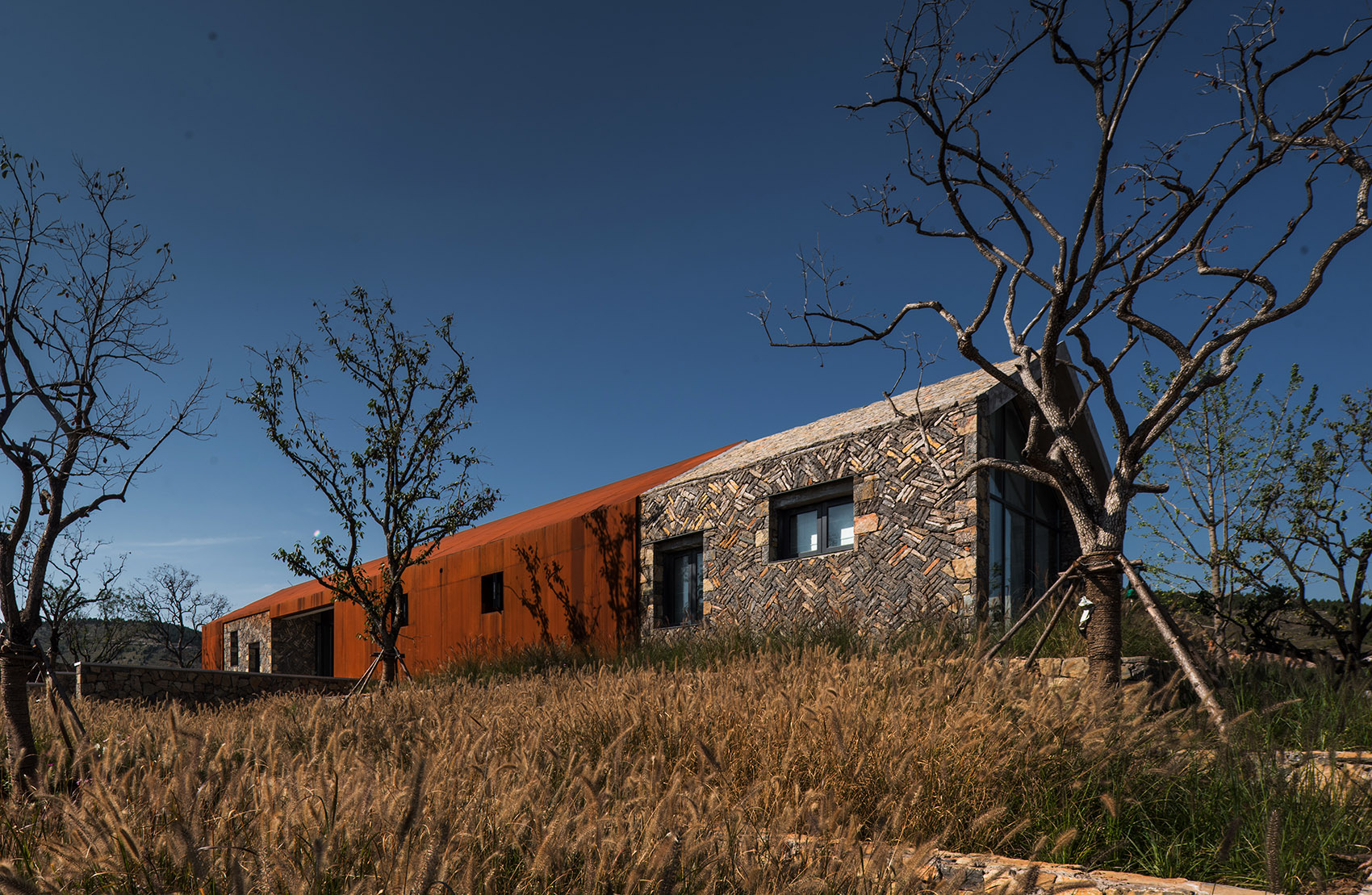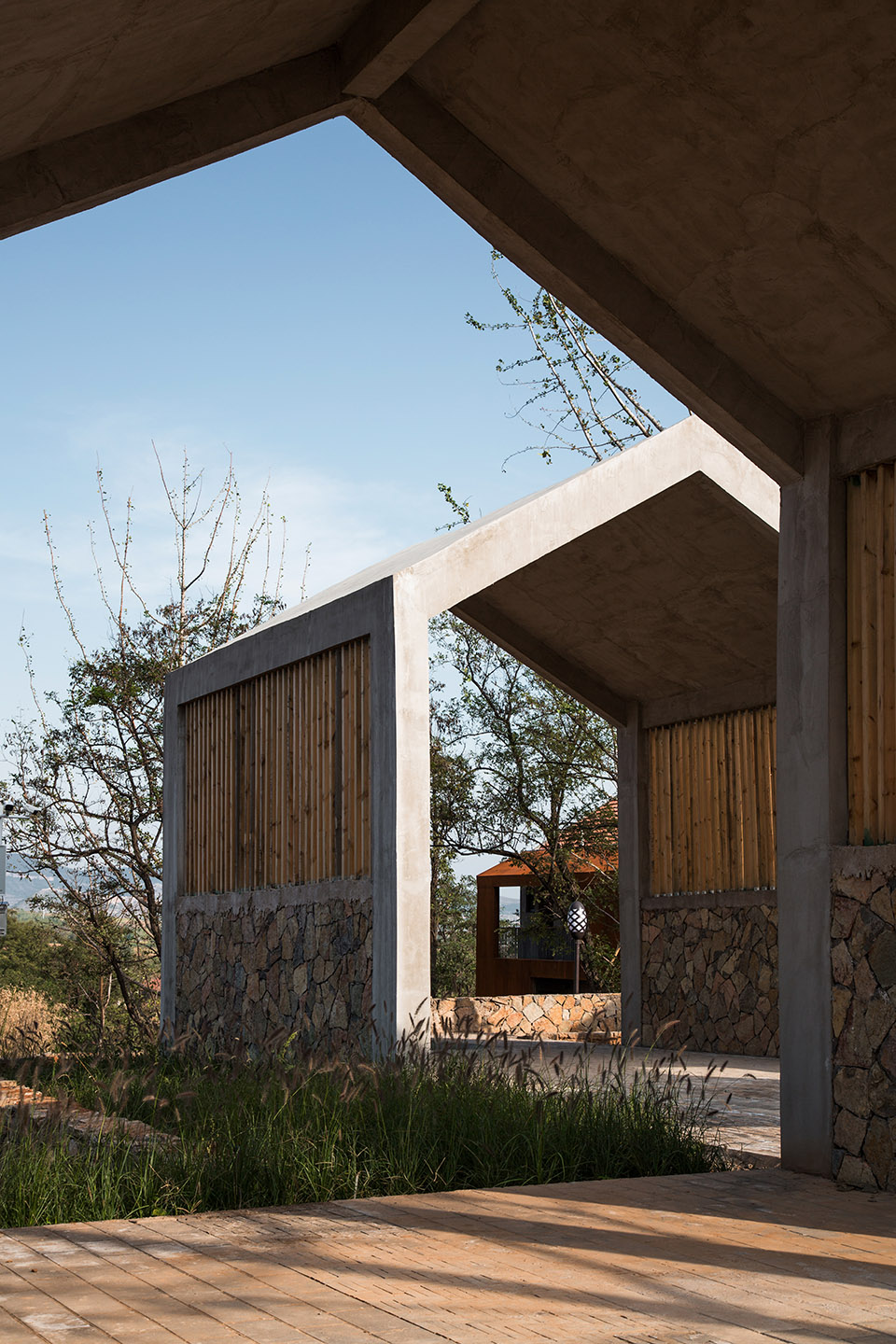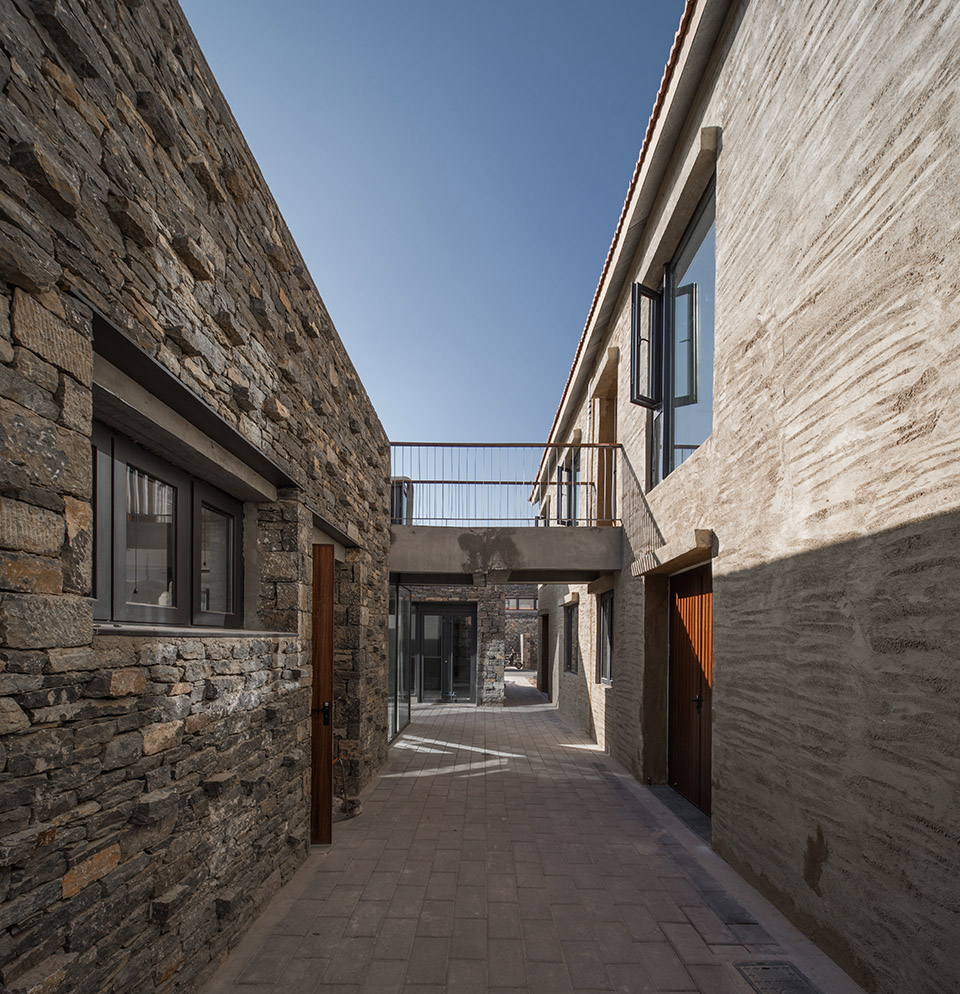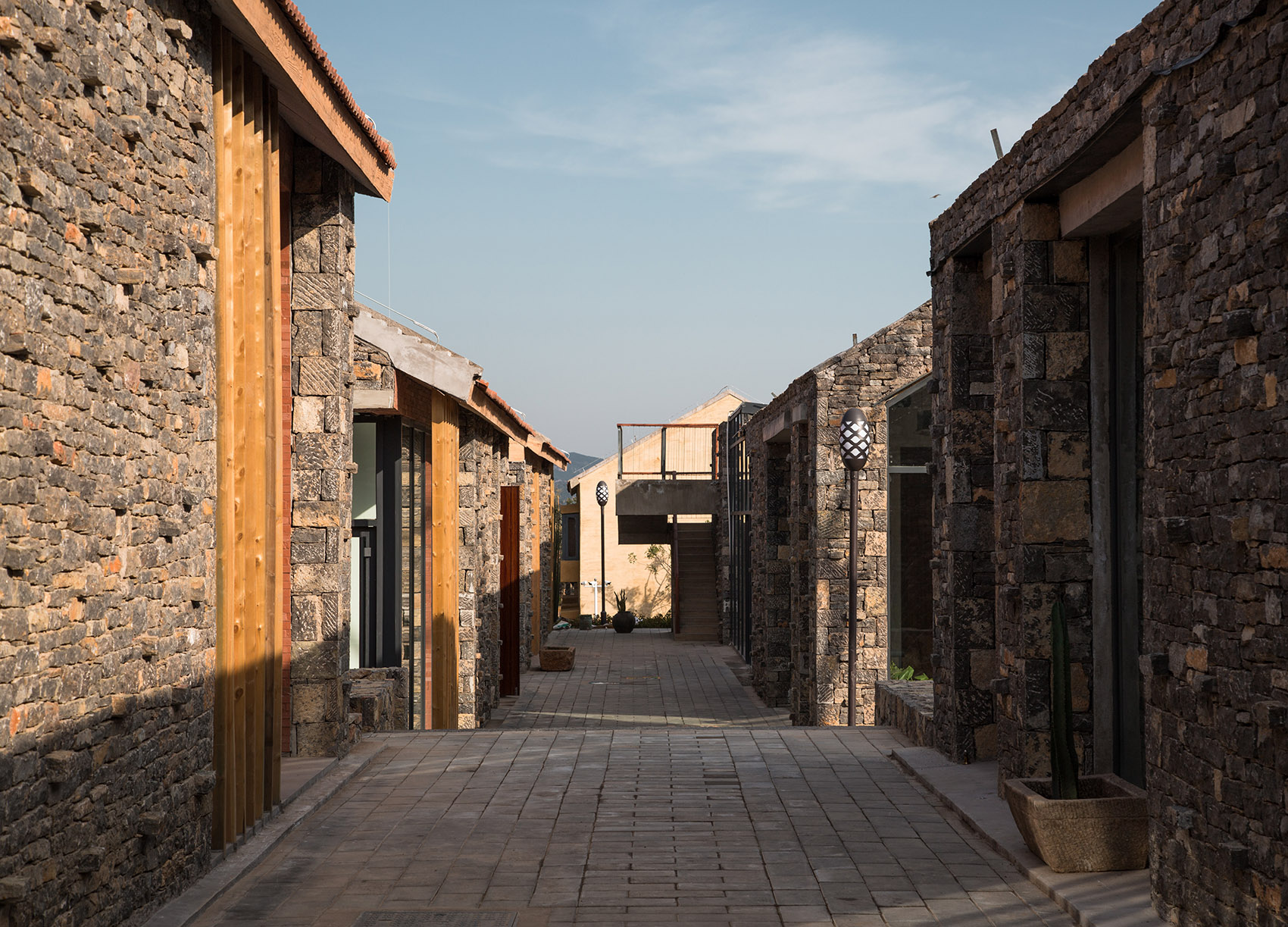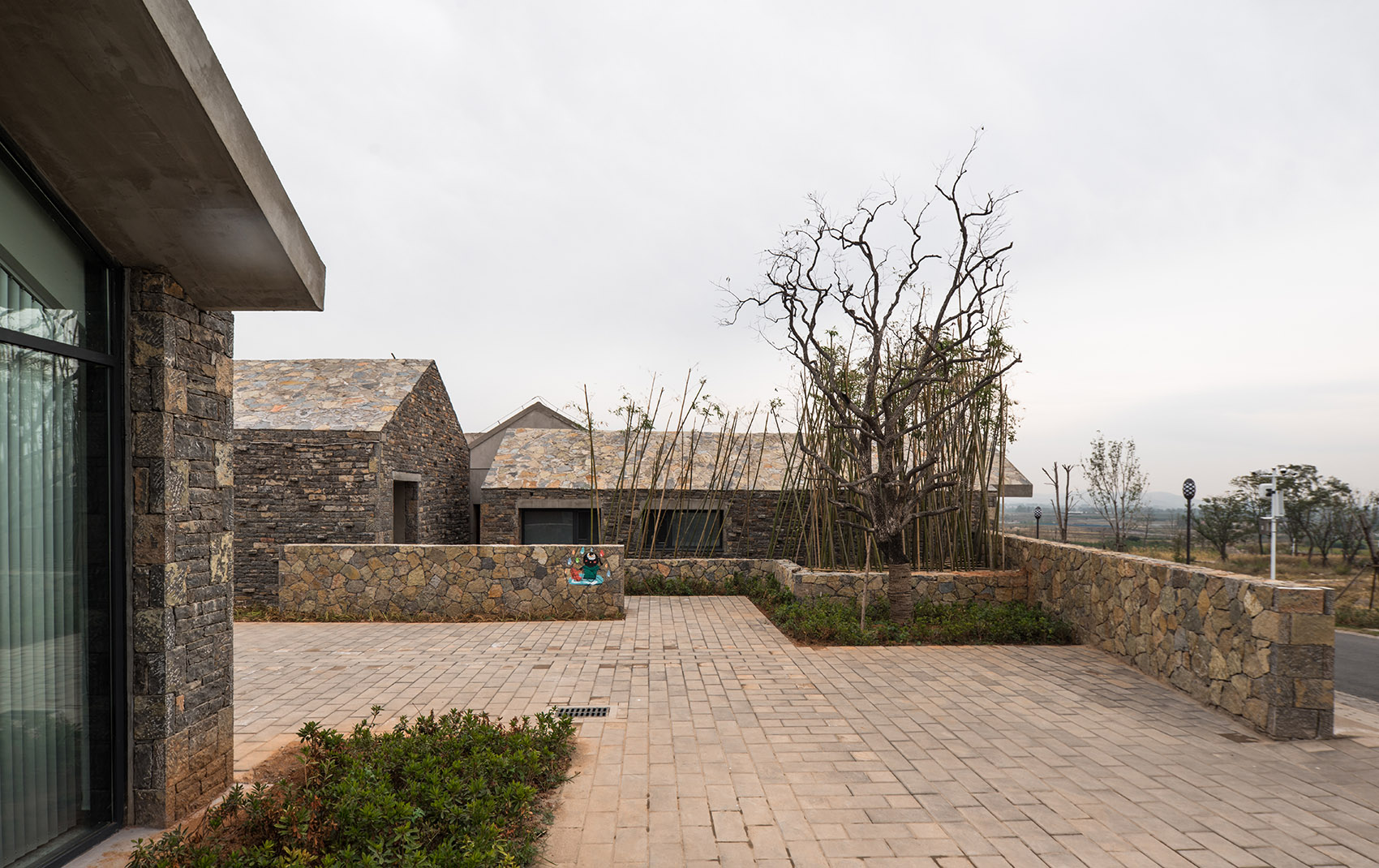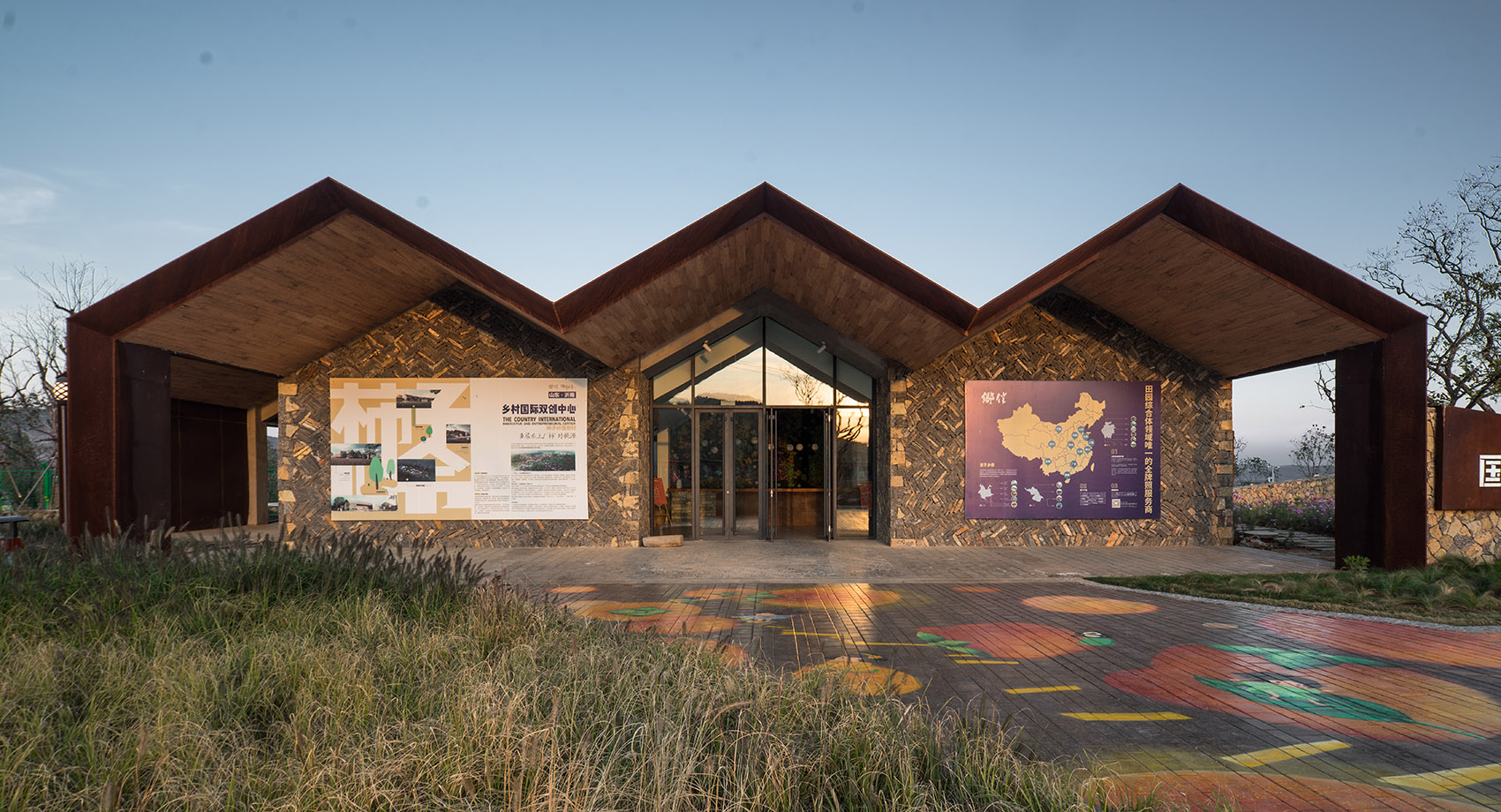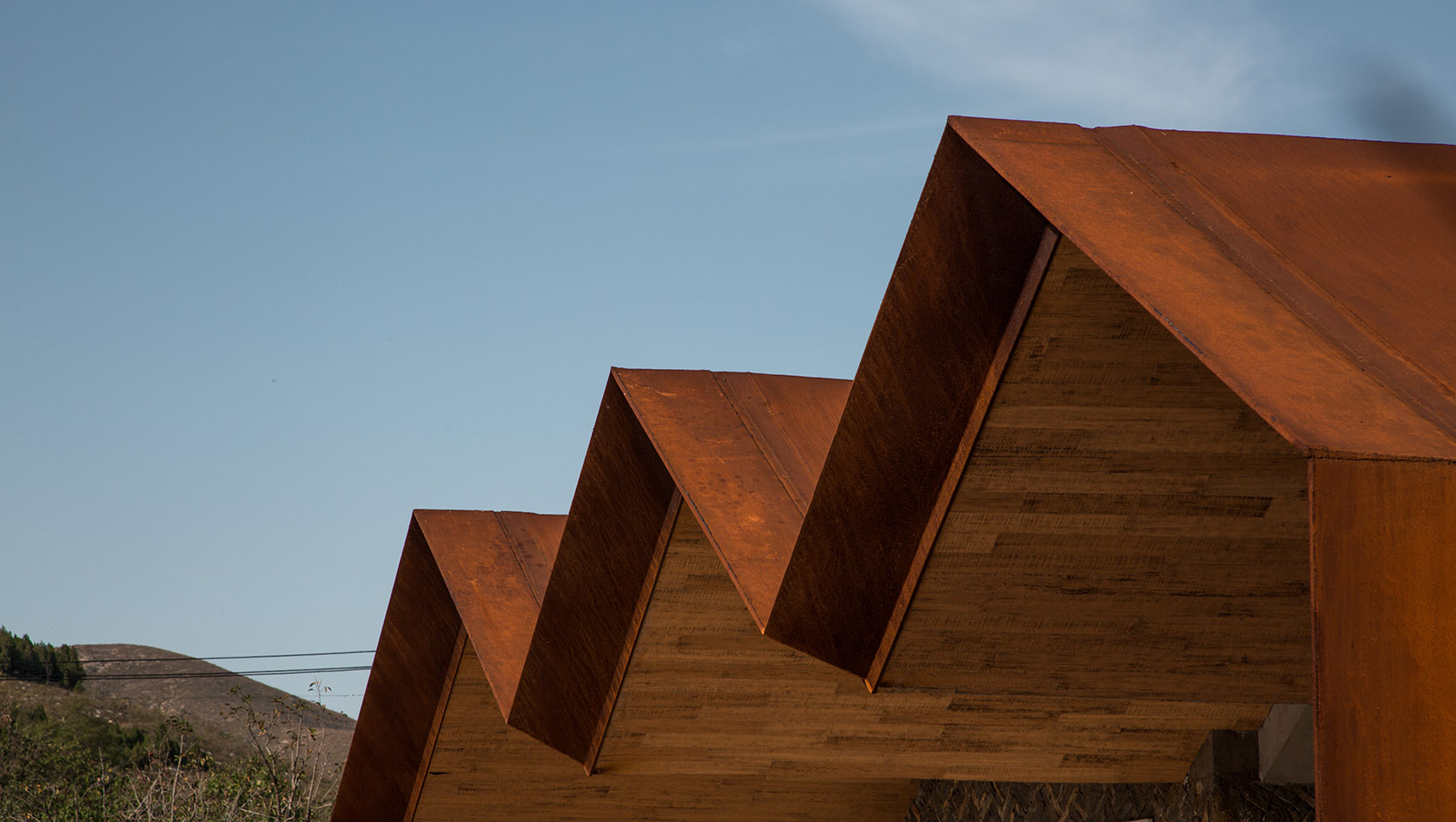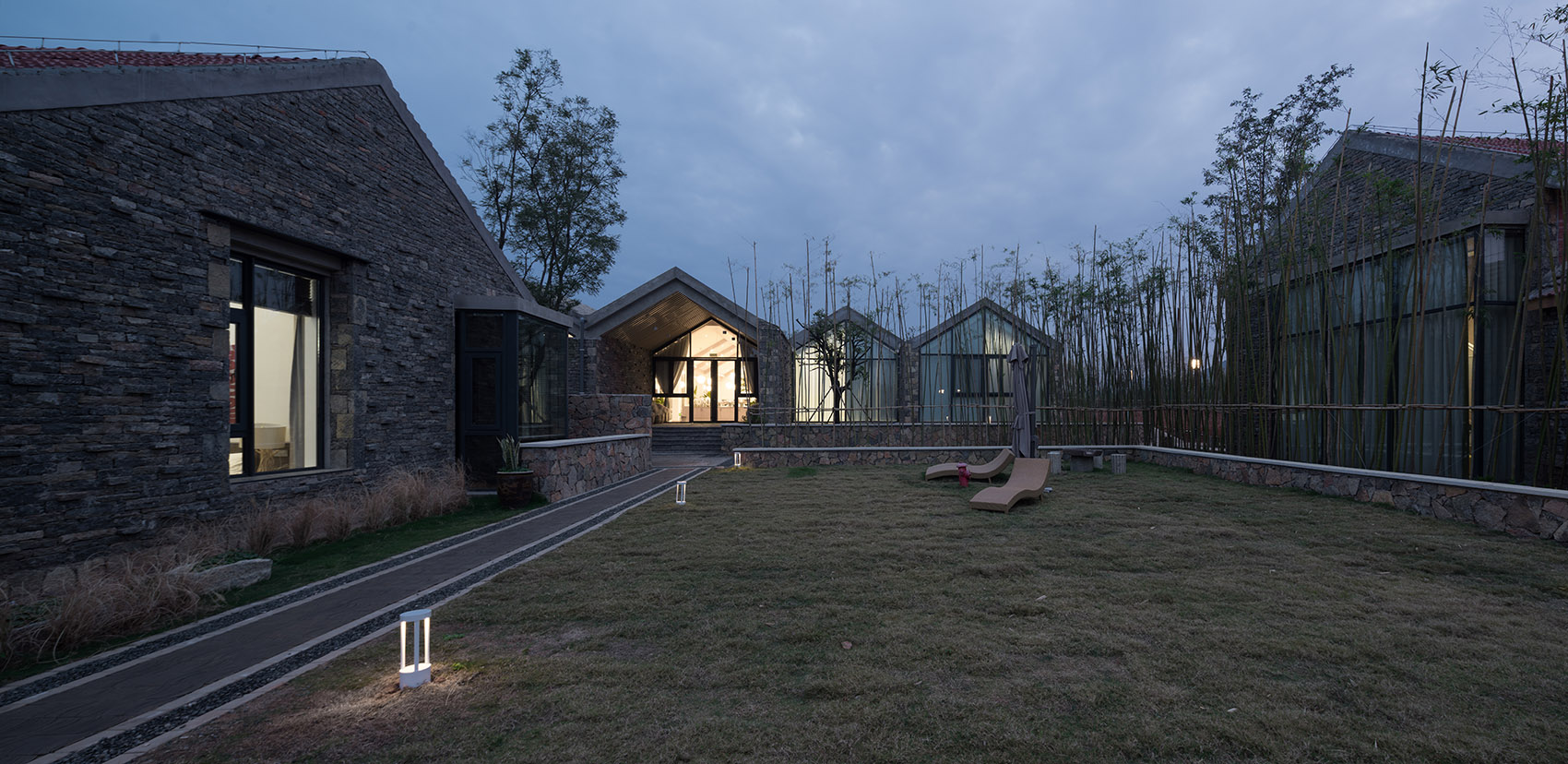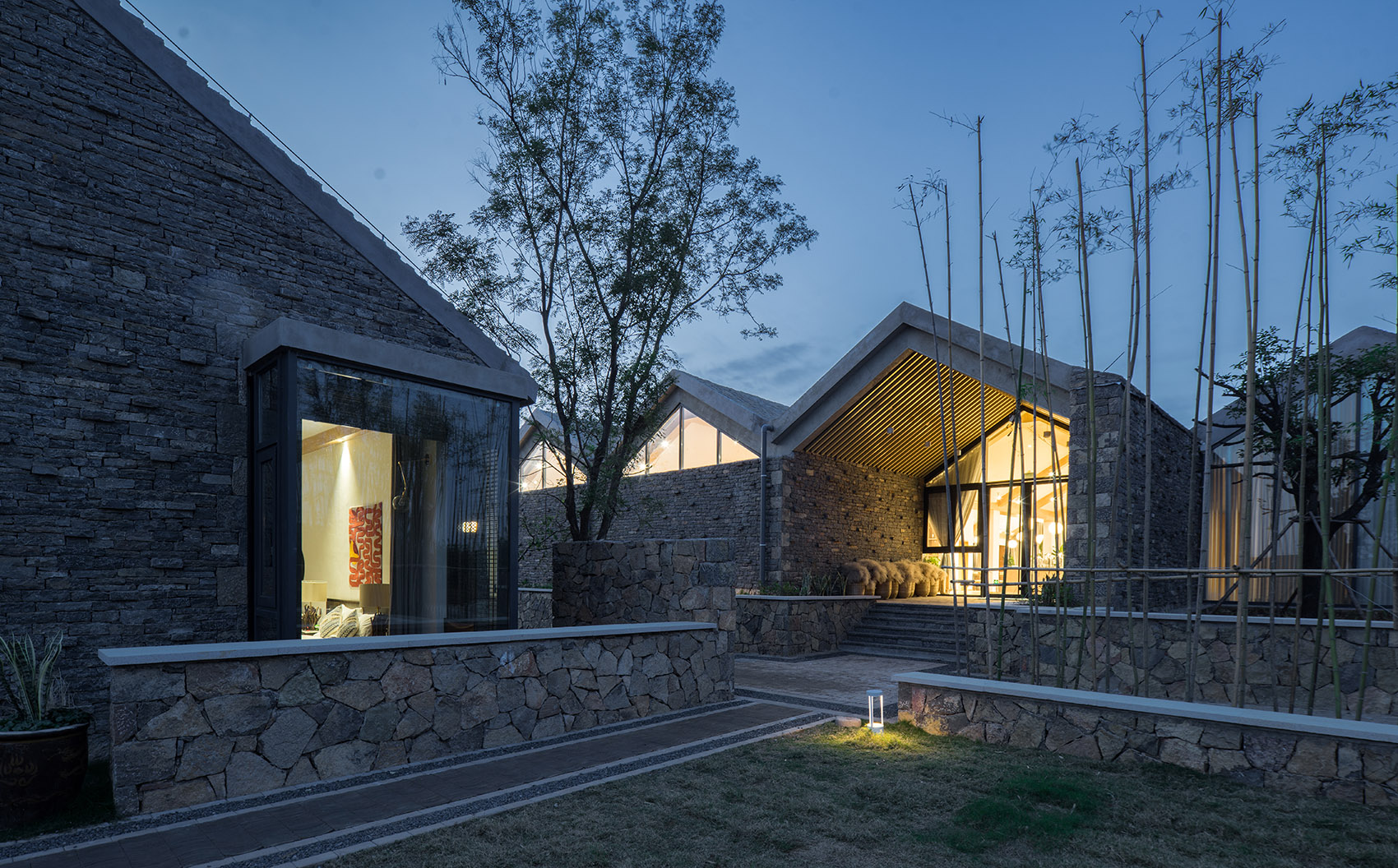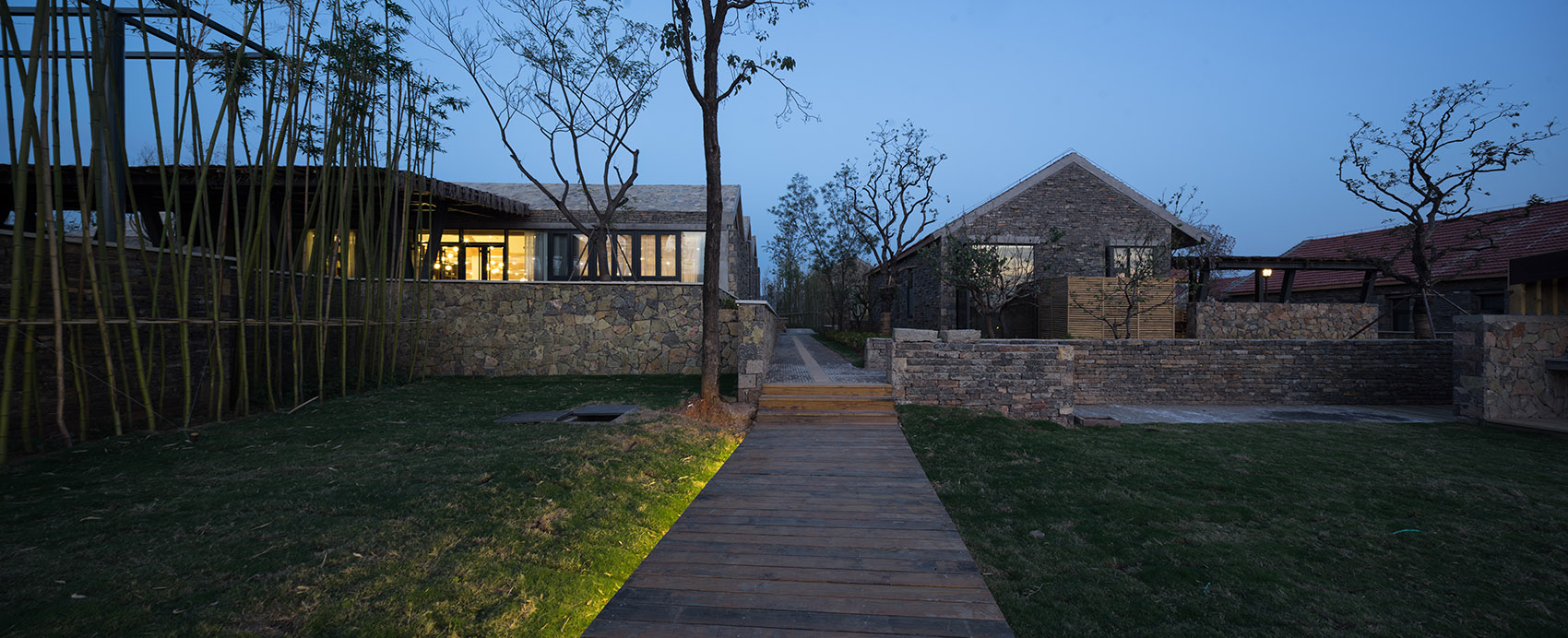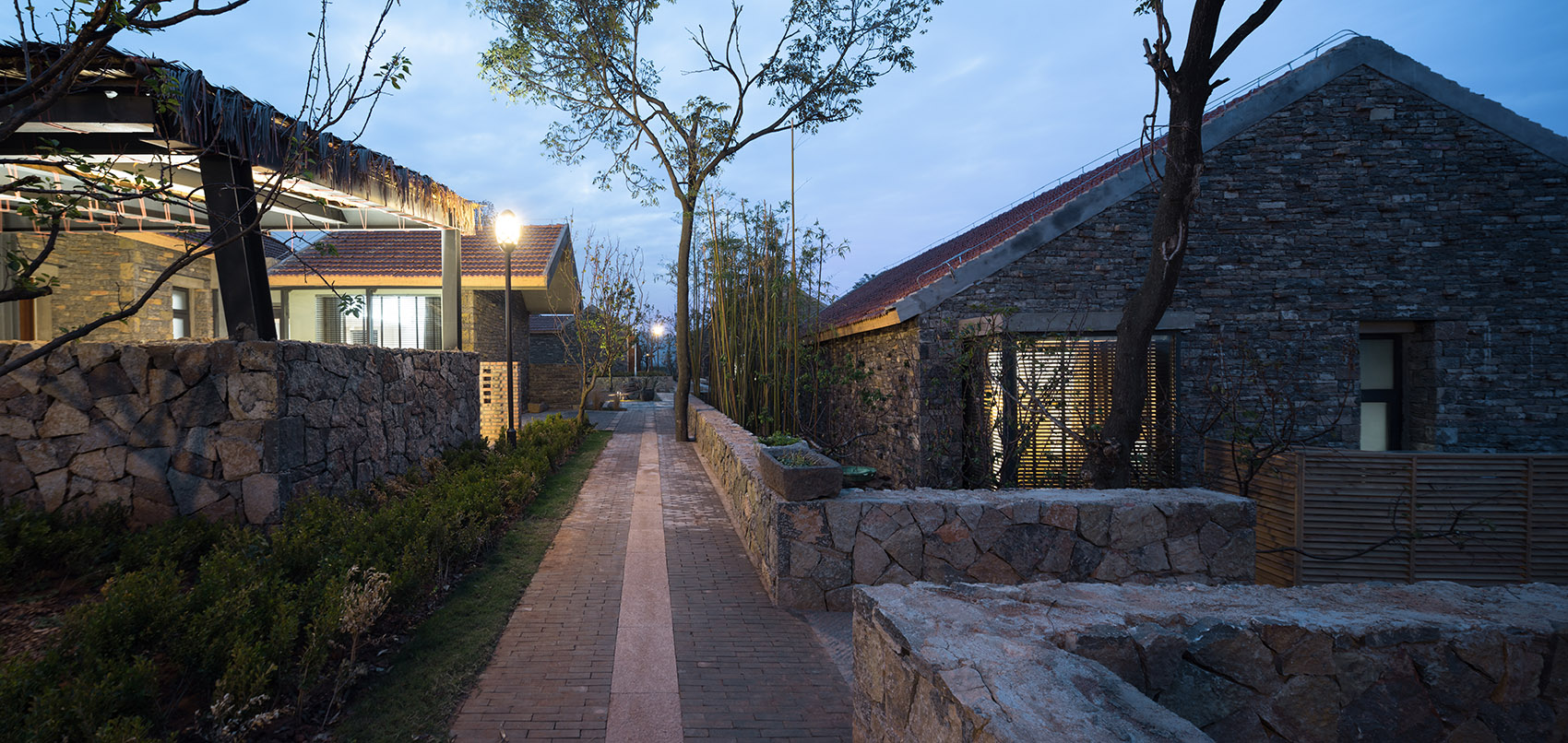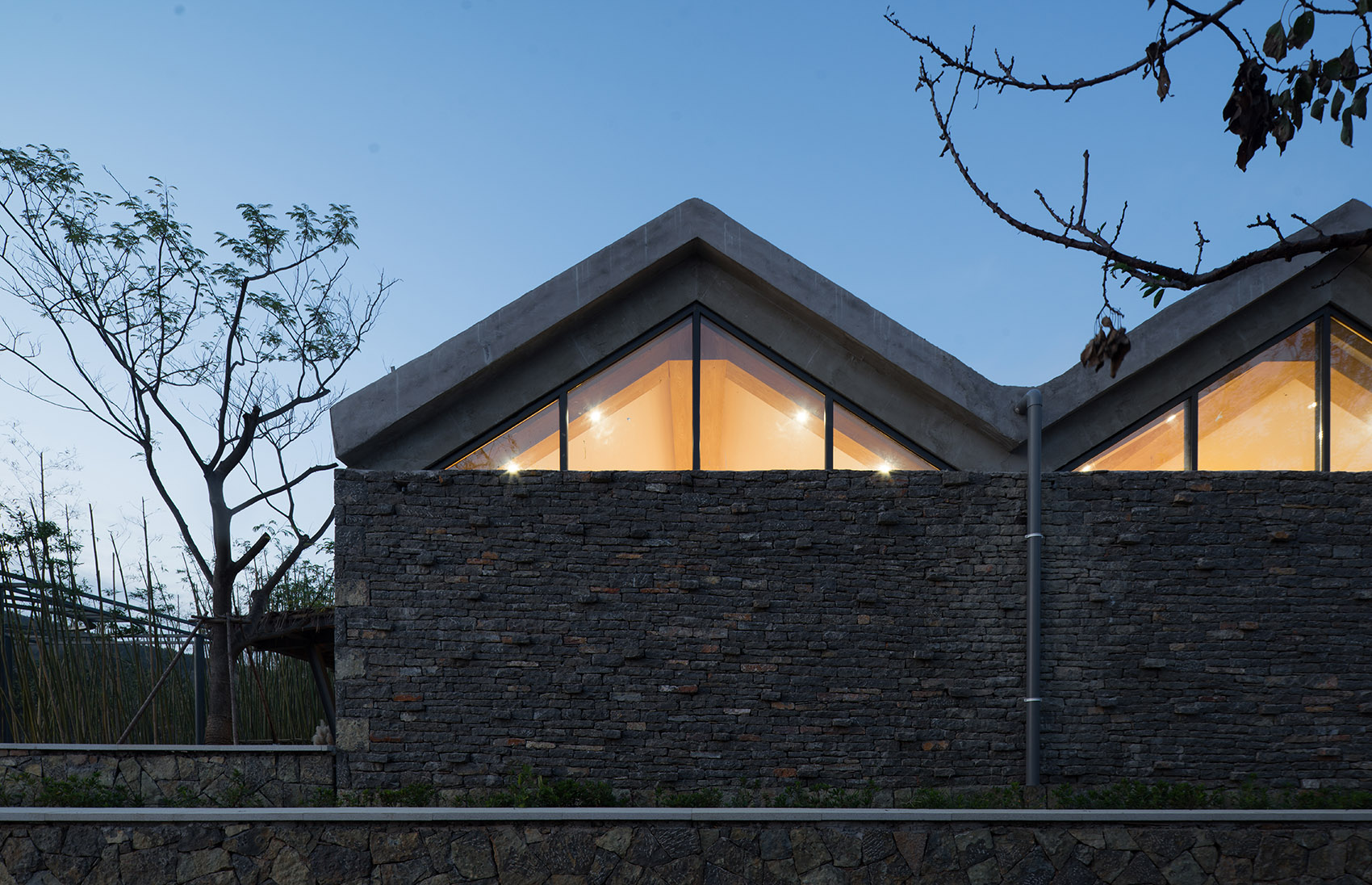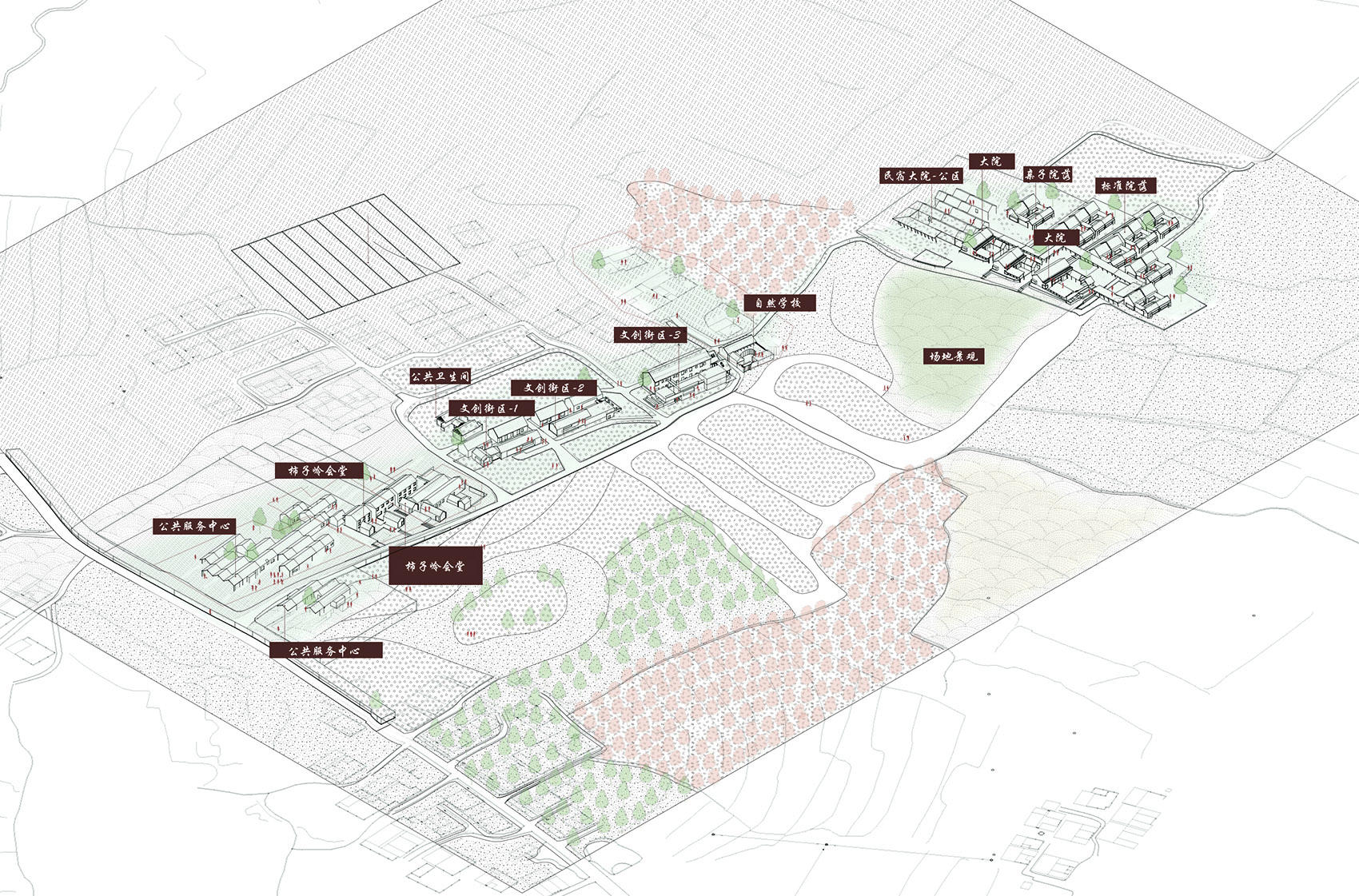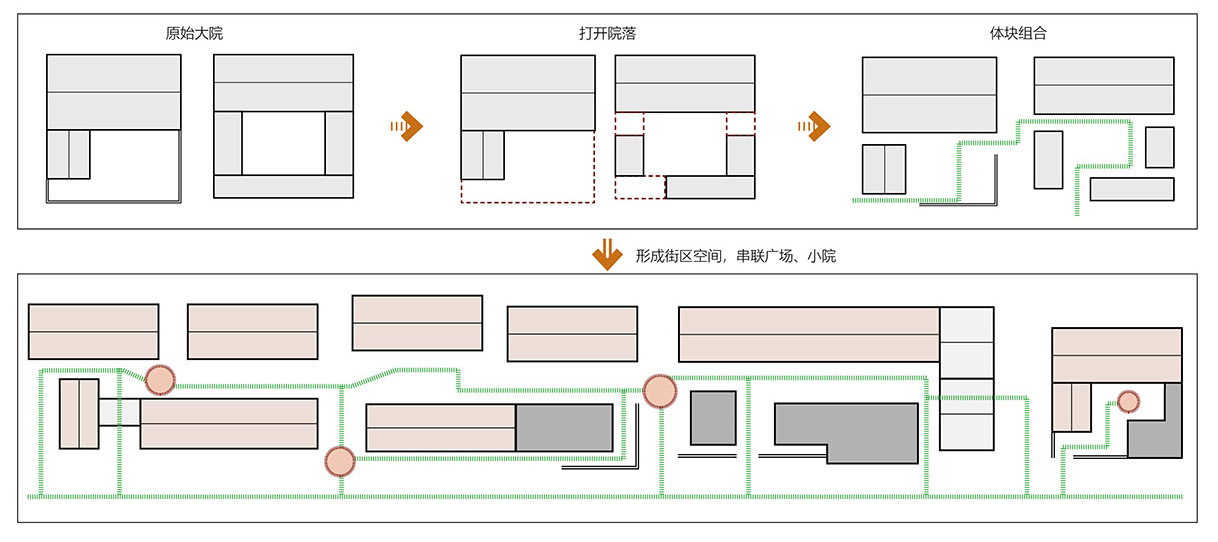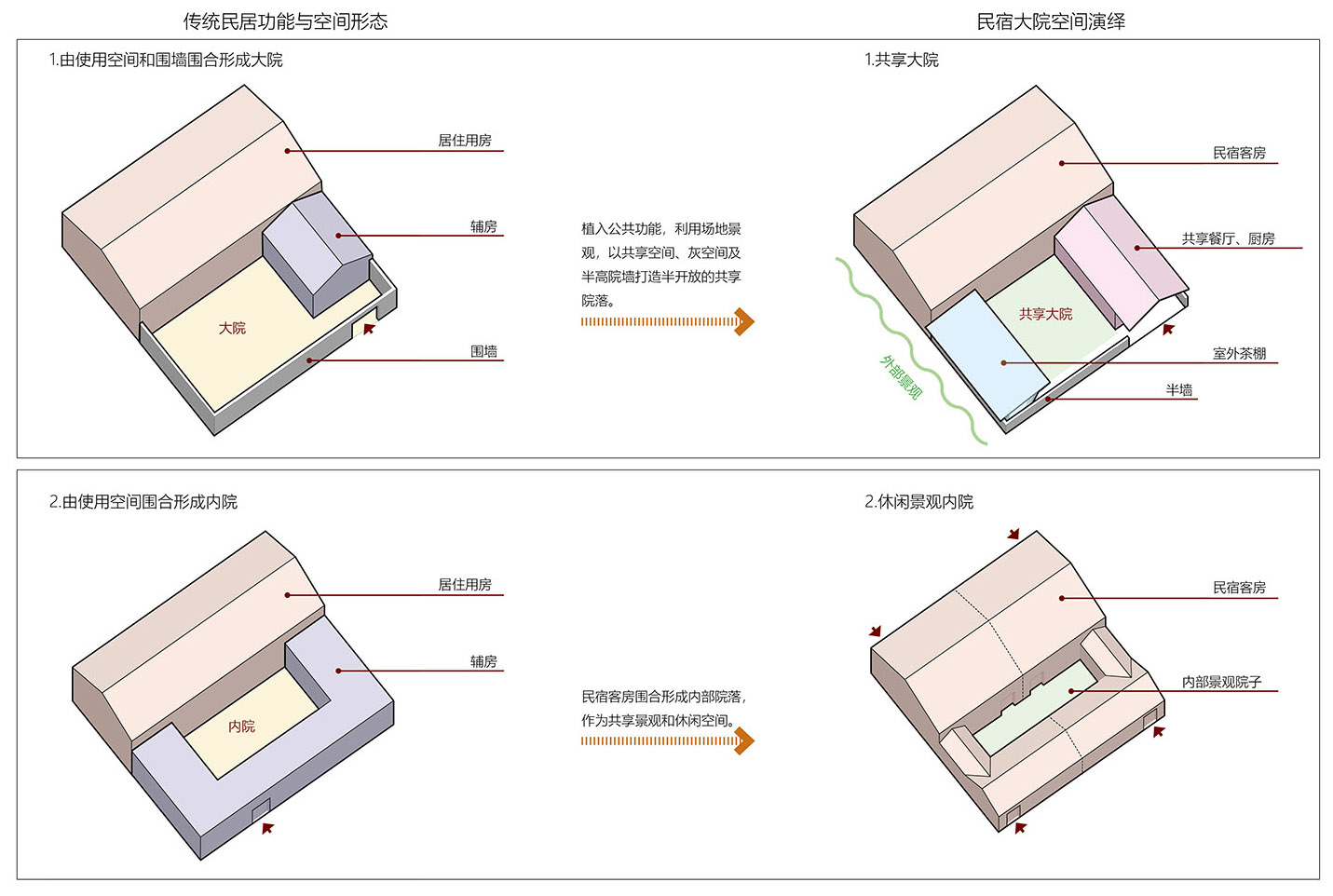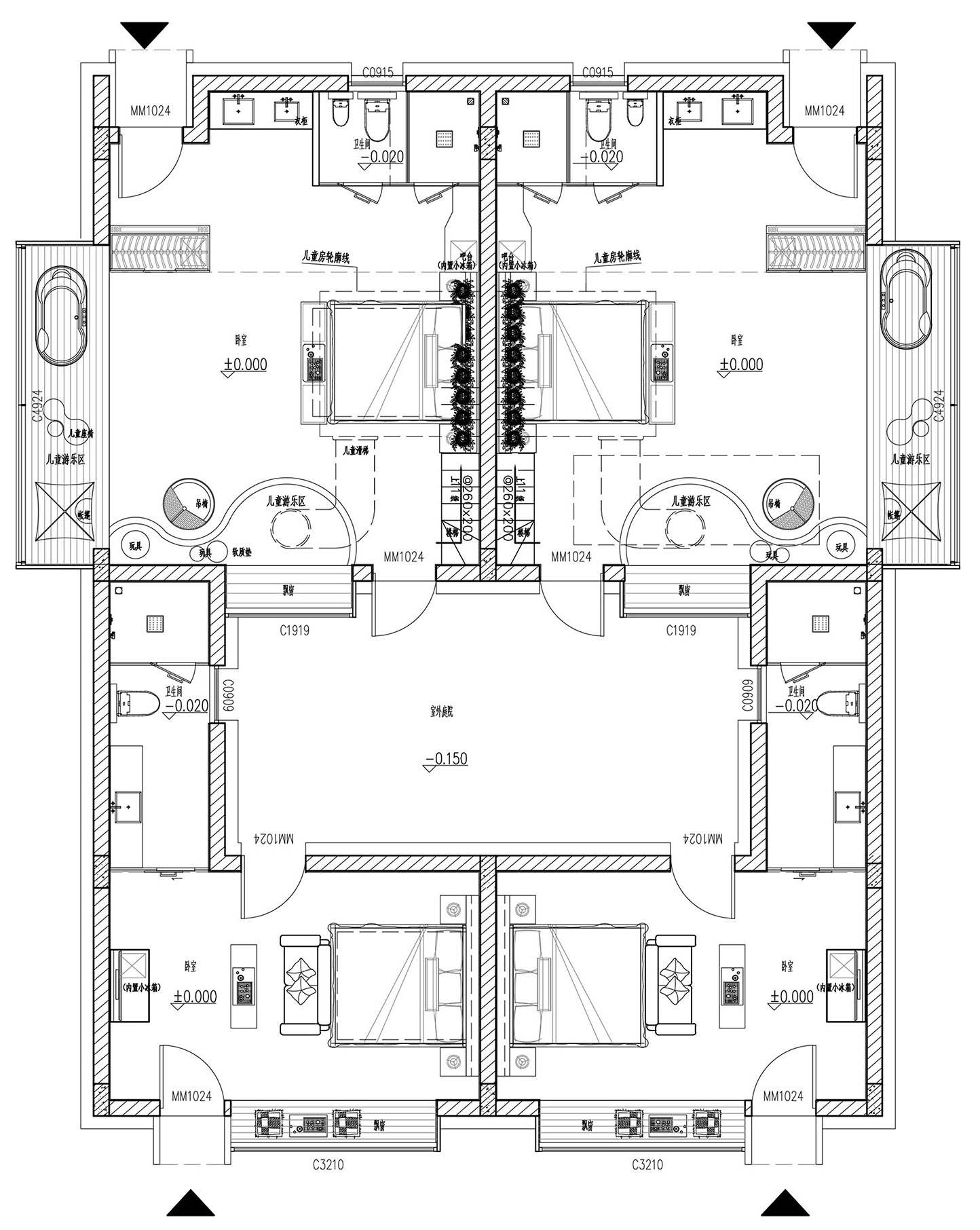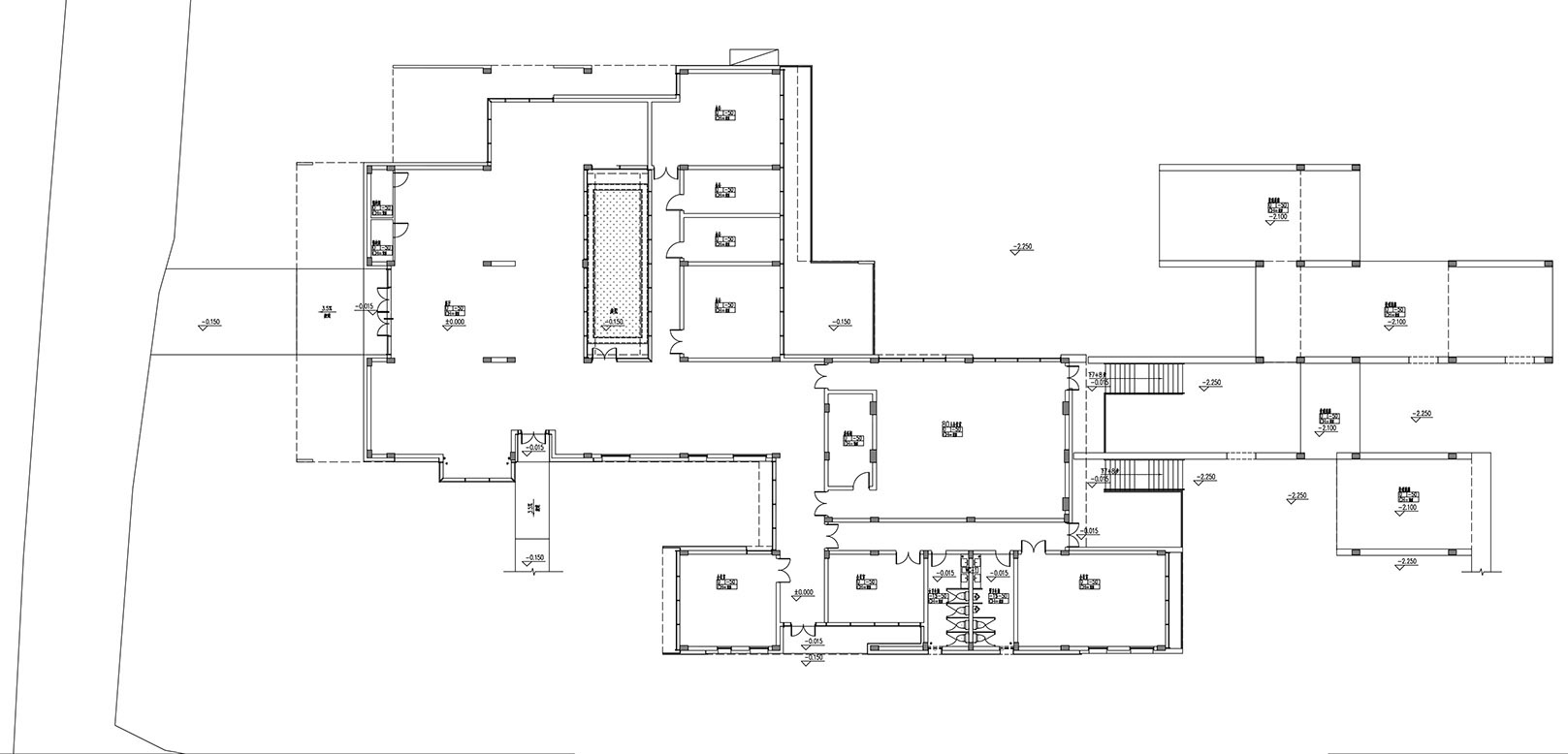柿子岭理想村位于山东省沂南县,是朱家林国家级田园综合体的重要节点。朱家林田园综合体以“文旅”为模式开展乡村振兴实践,通过四年的时间,从国家级试点到国家级示范,在全国的国家级田园综合体中脱颖而出。而柿子岭理想村作为其核心区域,以乡村形态为基础,发掘地方文化,提取乡土元素,从在地性出发,通过设计的介入,在建筑更新、空间活化、经济产业复兴、文旅产业发展等方面完成对柿子岭村落的更新与改造,打造齐鲁片区的第一个文旅乡村名片。
项目总规模约7600平方米,场地呈线性,自西向东沿村道逐渐深入田中。村道北侧是散落的民居,南面是成片的田野,向东到尽头,村院聚集,成组成团。这里乡村与自然交织,原始村落与大地之间的空间留白,蕴藏了更多场所的可能。我们从区位、交通、聚落肌理等方面着手,将柿子岭理想村的业态自东向西依次设定为民宿大院、文创街区和公共服务中心,功能由私密到公共,空间由封闭到开放,设计介入的力度逐渐加大。
Shiziling Ideal Village, located in Yinan County, Shandong Province, is an important node of Zhujialin National Pastoral Complex. Zhujialin Pastoral Complex carried out rural revitalization practice with the model of “cultural travel”. Through four years, it has stood out from the national pastoral complex in the country from the national pilot to the national demonstration. As the core area of Zhujialin, Shiziling Ideal Village explores local culture and extracts local elements based on the rural form. Starting from the locality, designers rebuild the county through the aspects of building renewal, space activation, economic industry revival and cultural tourism industry development, which to make Shiziling Ideal Village the represent of cultural tourism in Qilu area.
The total scale of the project is about 7,600 square meters. On the north side of the village road are scattered residential houses, and on the south is mount of fields. To the east to the end, the village courtyards gather to form a group. The countryside and nature are intertwined here, and the space between the original village and the earth contains the possibility of more stories. We started from the aspects of location, transportation, settlement texture, etc., and set the format of Shiziling Ideal Village from east to west as a homestay yard, cultural and creative block and public service center. The function is from private to public, and the space is from closed to open. , The design intervention gradually increased.
▼柿子岭村改造后鸟瞰,aerial view of Shiziling Village before and after renovation © 张坤
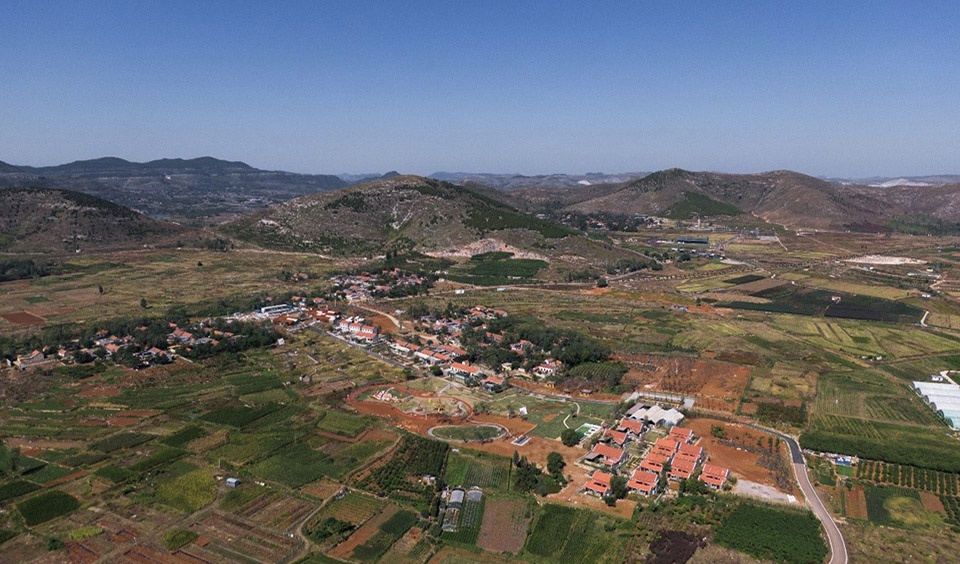
“院”是当地民居的典型空间形态,村东的民居聚落的原始肌理也是大院间的组合。数十座民宿坐落于场地原宅基之上,以民居大院平面形式为原型,恢复了传统的民居肌理,在空间、形制、材质等方面承袭对地域传统,形成相对独立的院落空间。
The “yard” is a typical spatial form of local houses, and the original texture of the village settlements is also a combination of large courtyards. Dozens of homestay yards based on the flat form of the residential courtyard, are located on the original homestead of the site. They restore the traditional texture of the residential houses, inherit the regional tradition in terms of space, shape and material, and form a relatively independent courtyard space.
▼民宿大院整体鸟瞰,aerial view of the entire Homestay Courtyard © 张坤
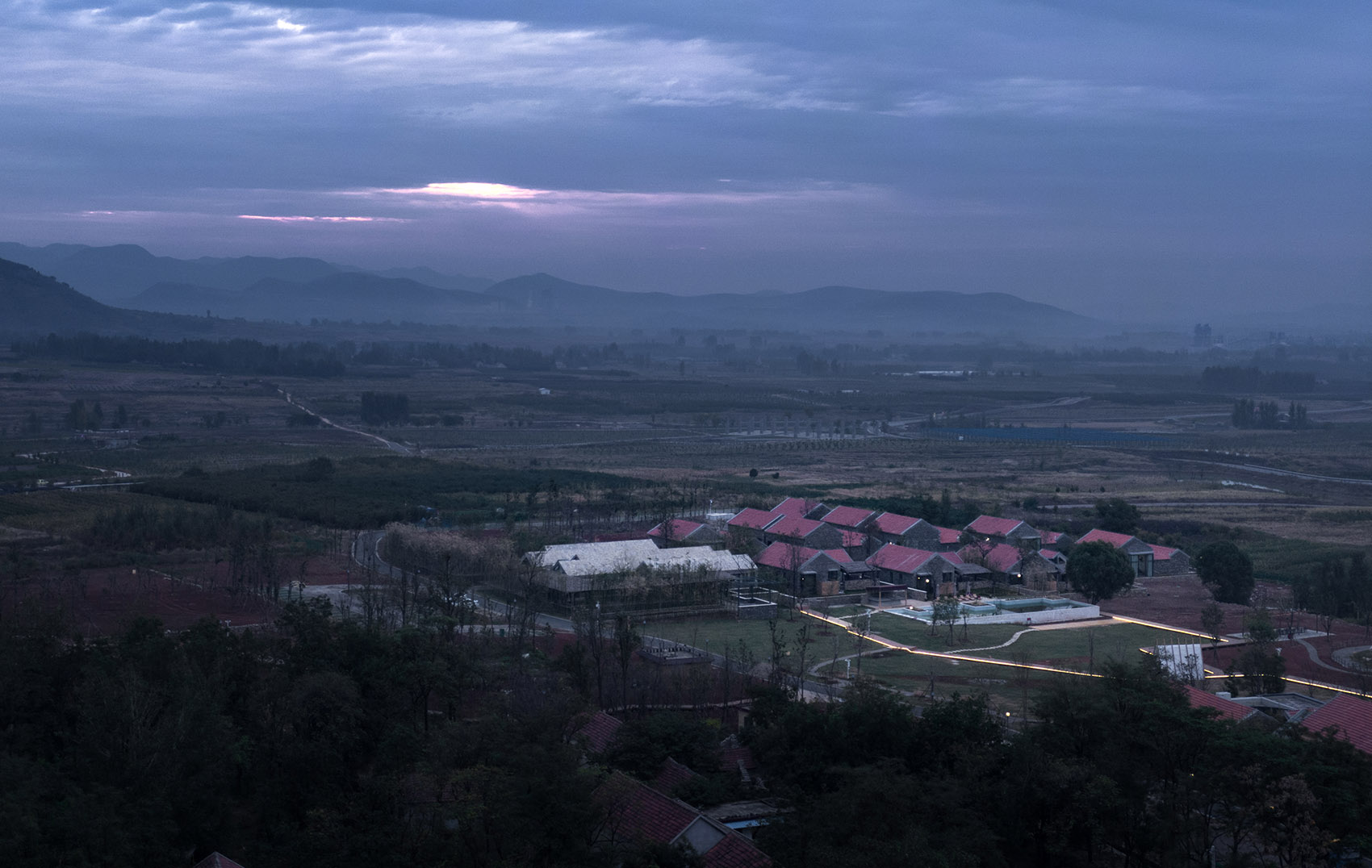
民宿院落分为大院民宿、标准院落民宿和亲子院落民宿,提供商务、休闲、亲子互动的室内外生活场所。为了满足现代人的生活需求,在民宿院落北边、靠近村路的方向设置了一座大院公区,主要提供民宿的接待和餐饮服务,在民宿院落中也植入了公共厨房、共享客厅、庭院茶棚等生活空间,赋予传统居住空间现代社交属性。在这里,体验的是乡村环境中的现代生活。传统民居中一家所有的场院,通过微小的改造,成为友人、家庭、孩童间交流互动、聚集娱乐的场所。院落空间与不同住户的生活情境的碰撞,赋予每个院子个性和精神。
The homestay courtyards include the large courtyard homestay, the standard courtyard homestay and the parent-child courtyard homestay, providing indoor and outdoor living places for business, leisure and parent-child interaction. In order to meet the living needs of modern people, a public building is set on the north side of the homestead and near the village road. It mainly provides reception and catering services for the homestay. A common kitchen, shared living room and courtyard are also implanted in the homestay courtyard. Living spaces such as tea sheds endow traditional living spaces with modern social attributes. Here, you experience modern life in a rural environment. In a traditional residential house, the courtyards space has been transformed into places for friends, families, and children to interact and gather and entertain. The collision of the courtyard space with the living conditions of different residents gives each courtyard a personality and spirit.
▼民宿大院,the Homestay Courtyard © 张坤
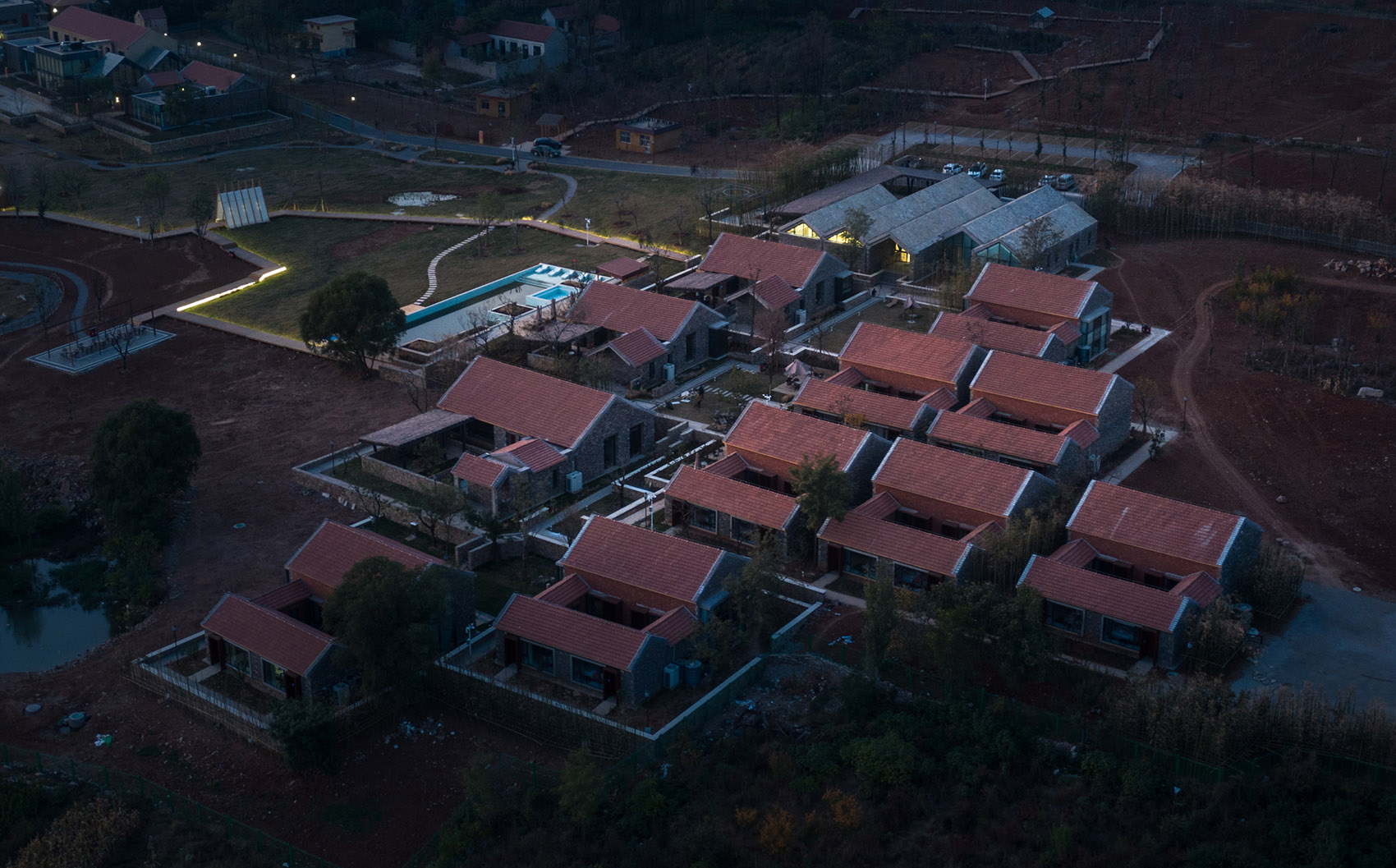
▼大院公区,public area of the Homestay Courtyard © 张坤
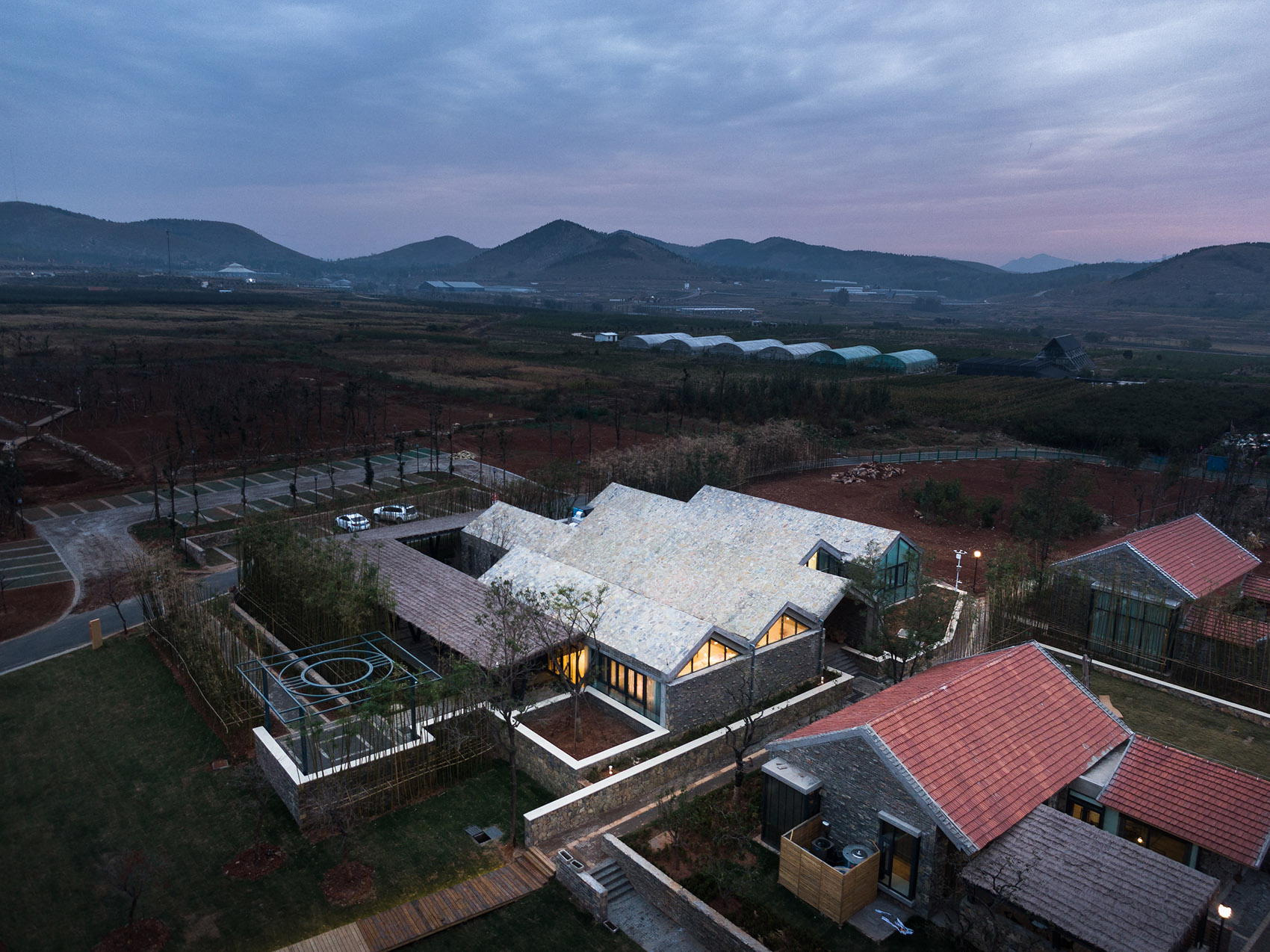
民宿大院在功能植入和空间营造上融合了对现代生活方式的思考,材质、建造手法则沿袭民居的做法。公区采用由传统坡屋顶演变而来的折面屋顶覆盖公共活动空间,以此表达建筑在群落中的公共性。同时为了强调组团建筑的传统性,公区建筑以垒石作为立面以及屋顶的主要材料,入口处采用当地常见的茅草棚加以引导,建筑仿佛破土而出。民宿大院以垒石、红瓦为主,充分表达对地方风貌的尊重和传承。大院之间的街巷保持着传统村落的尺度,大大小小的邻里空间串联在人行巷道中,成为聚落里的公共场所。从公区出发,沿着蜿蜒曲折的步道,可以穿梭在院落、场地景观和外围田野之间,感受民宿大院组团丰富的空间层次。
▼大院公区,public area of the Homestay Courtyard © 张坤
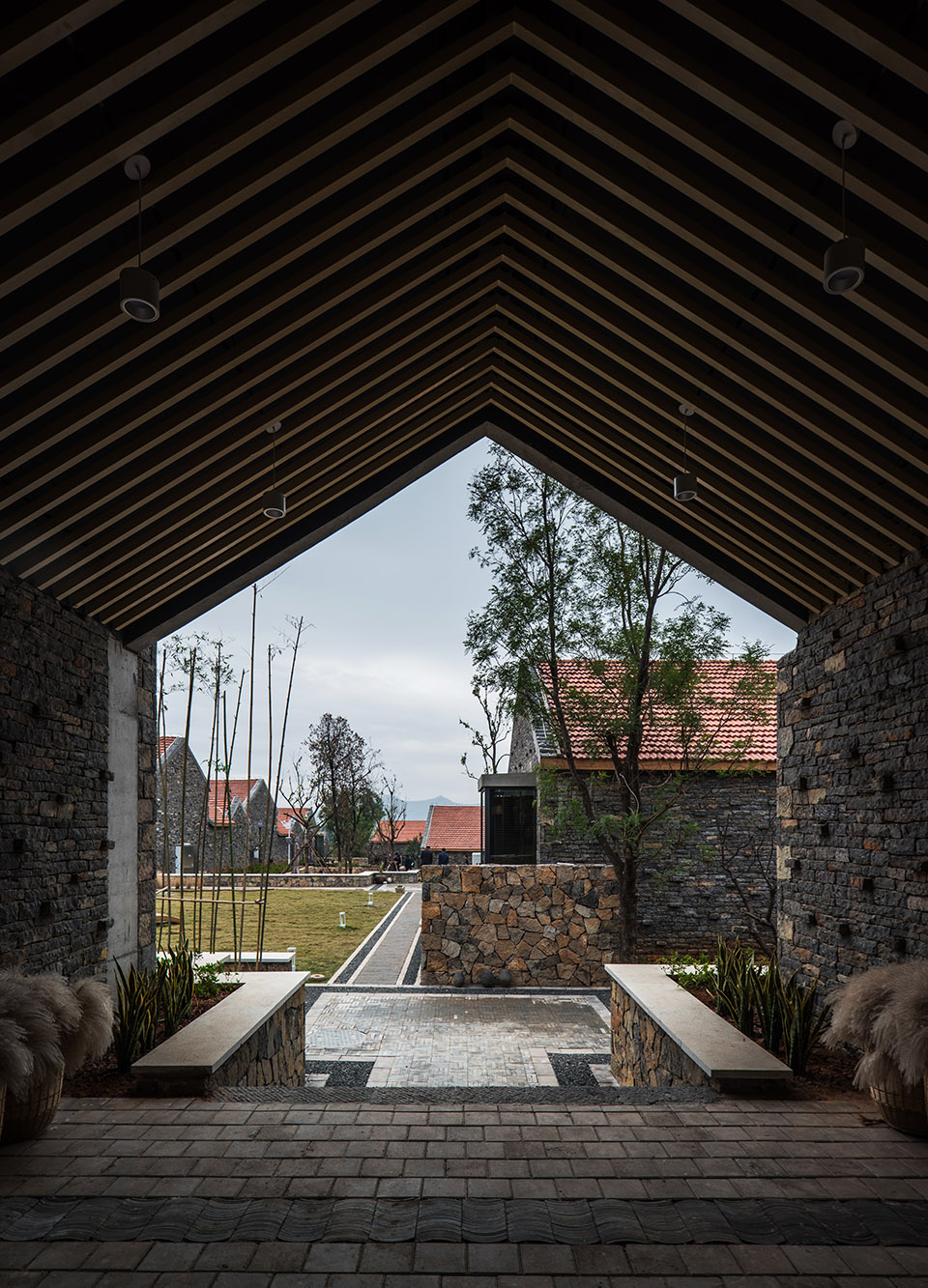
The homestay courtyard integrates the function of modern lifestyle. But during the construction, designers follow the practice of traditional residential houses. The public area adopts the folded roof evolved from the traditional slope roof to cover the public activity space, so as to express the publicity of the building in the community. At the same time, in order to emphasize the traditional nature of the group building, the public area building uses stone as the facade and the main material of the roof. The entrance is guided by the common thatched shed, and the building seems to break out of the earth. The courtyard of the homestay is dominated by ramparts and red tiles, fully expressing the respect and inheritance of the local style. The lane between the courtyards maintain the scale of traditional villages, and large and small neighborhood spaces are connected in series in pedestrian lanes to become public places in the settlement. Starting from the public area, along the winding path, you can shuttle between the courtyard, the site landscape and the surrounding fields, and feel the rich spatial level of the courtyard area.
▼穿梭在民宿大院中,go through the Homestay Courtyard © 张坤
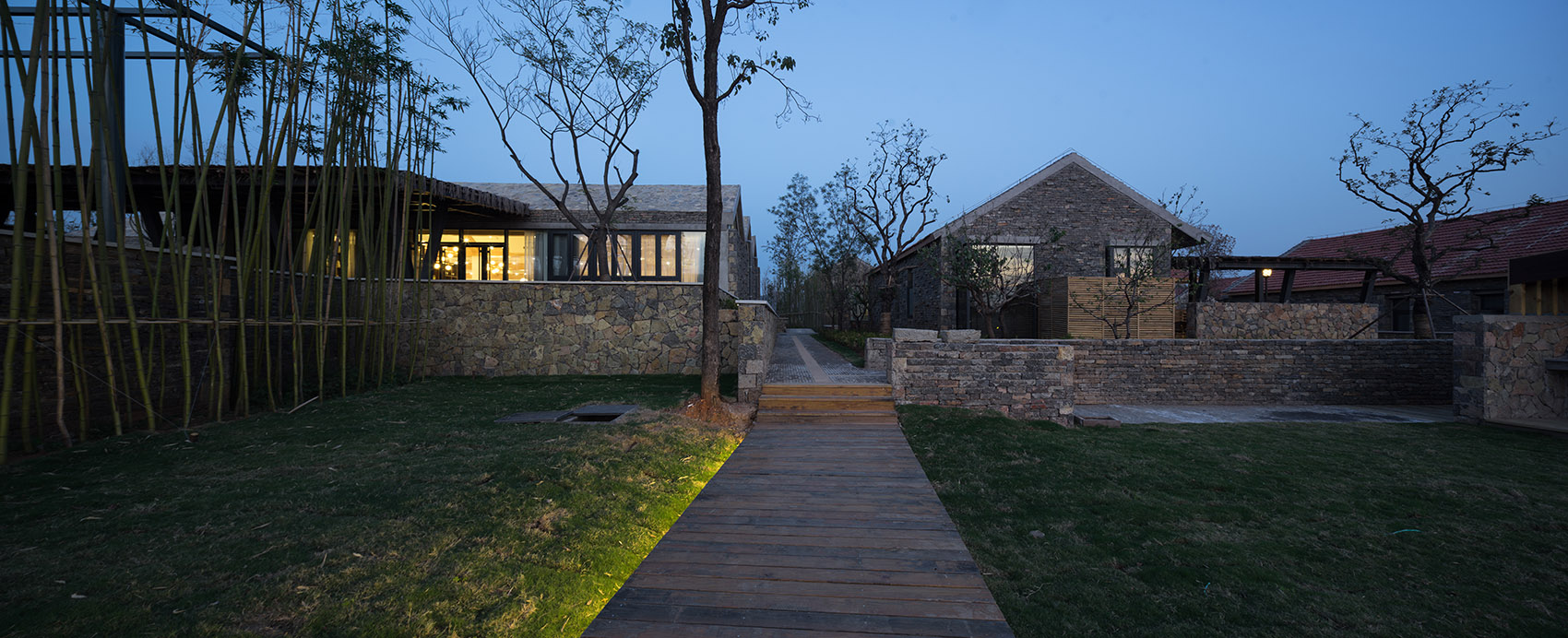
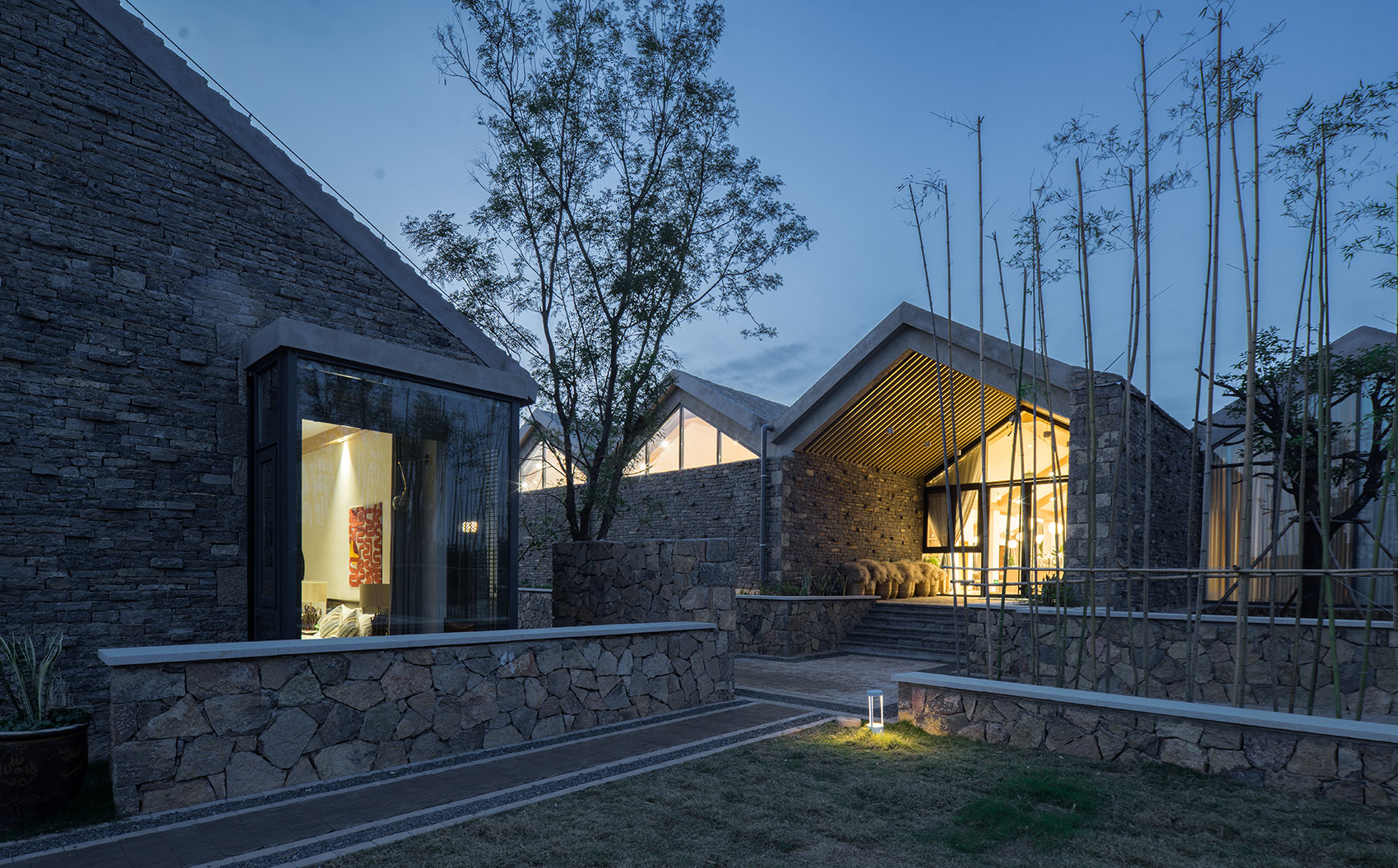

村落中部组团背靠宅院,面对道路与田野,线性的肌理暗含着导向性。我们利用这种空间导向,将邻里空间放大、拉长,以原始的院落肌理为基础,打开围墙,串联内院,多个“被拆解”的院落成组团,形成街区式空间序列。
The group in the middle of the village is in front of the residences, facing the road and the field, the linear texture implies guidance. We use this space orientation to enlarge and lengthen the neighborhood space. Based on the original courtyard texture, we open the surrounding walls and connect the inner courtyards. Multiple dismantled courtyards form a block-like spatial sequence.
▼文创街区鸟瞰,aerial view of The Block © 张坤
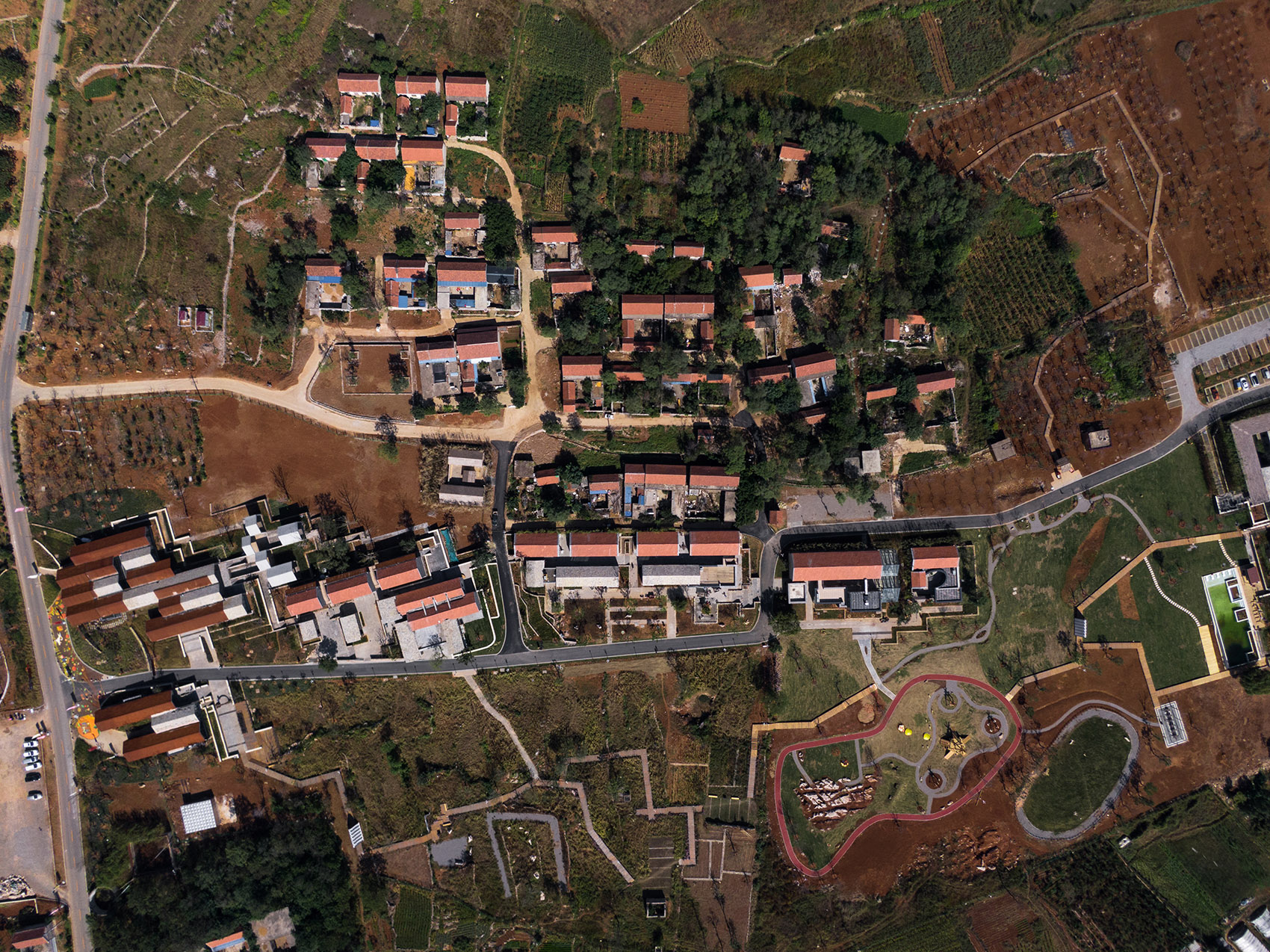
院落形式的开放、组合,将“前院后宅”的空间形式转变成内街、广场、半围合小院的串联,营造了开放的街区场景氛围。道路南边对场地进行整理与微改造,布置了栈道、帐篷、无动力儿童游乐园等活动场所,还原了乡村田野的原始乐趣。大地景观成为街区游历体验的外延,也是大院和街区之间的自然过渡。
The courtyard form is opened and combined, and the spatial form of “front yard and back house” is transformed into a series of inner streets, squares, and semi-enclosed small courtyards, to create an open street scene atmosphere. On the south side of the road, the site was sorted and slightly transformed, and planks, tents, unpowered children’s amusement parks and other activities were arranged to restore the original fun of rural fields. The landscape of the earth becomes an extension of the block-travel experience and a natural transition between the courtyard and the block.
▼场地景观,site landscape © 张坤
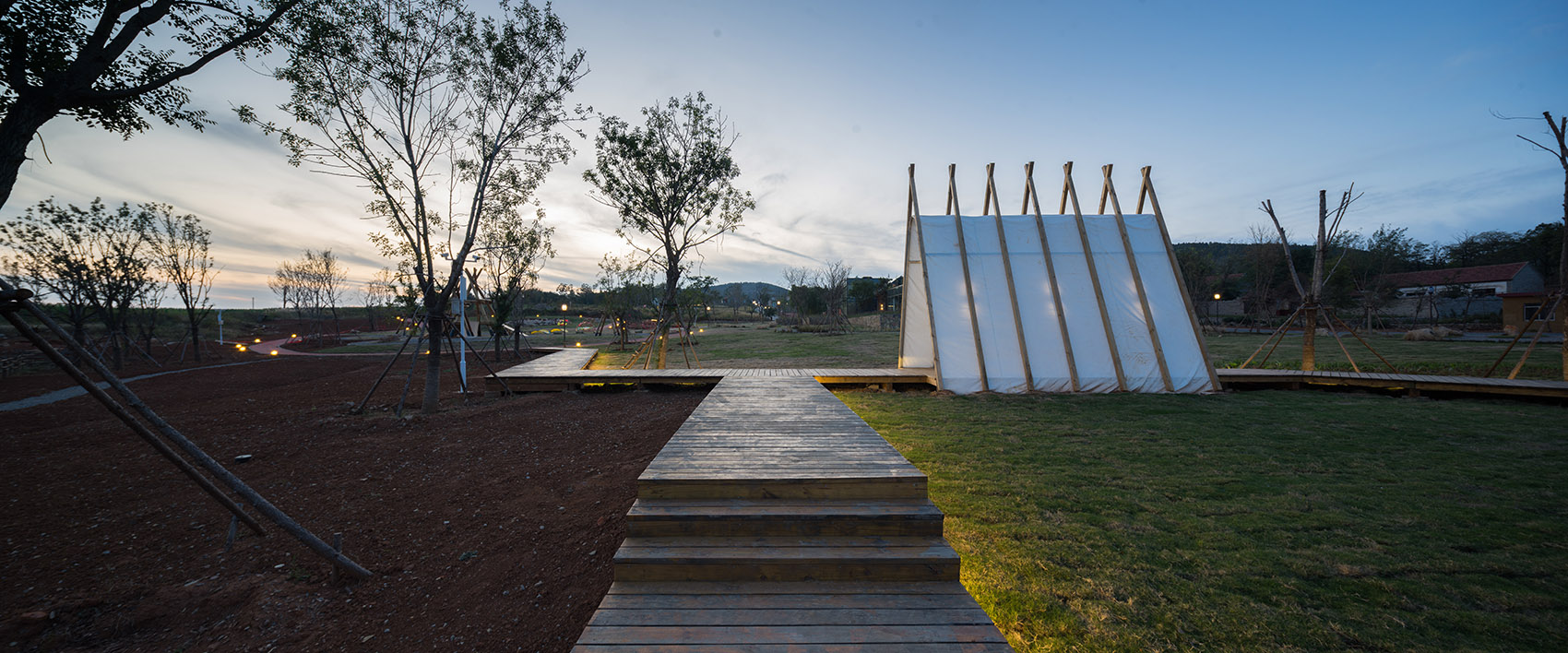
乡村街区整体以石材为主,搭配木头、玻璃等元素,在局部开放和展示空间处加以强调,增强了街区体验的趣味性。
街区业态涵盖农创、乡创、文创等多方面的复合体验,有文创商店、手工作坊、乡村集市、餐厅、自然学校。这里将富有当地特色的作物、民俗、手艺进行二次创意,送进课堂学习,端上桌面体验,放进橱窗展示,装进口袋带走,为村民提供新的就业机会,给游客充满地域特色的体验,让地方特色传承和发扬,使乡村产业以开放的姿态得以发展。
The whole village block is mainly made of stone, with elements such as wood and glass. It is emphasized in the local opening and display space, which enhances the fun of the block experience.
The block format covers multiple aspects of agro-creative, rural-creative, cultural and creative experiences, including cultural and creative shops, handicraft workshops, village fairs, restaurants, and nature schools. Here, the local creative crops, folklore, and craftsmanship are used for secondary creativity, sent to the classroom for learning, served on the desktop experience, put in the window display, and taken away with imported bags, providing new employment opportunities for the villagers and giving tourists the locality experience learning, make local characteristics be inherited and carried forward, so that rural industries can develop in an open attitude.
▼文创街区内街,inner streets at The Block © 张坤
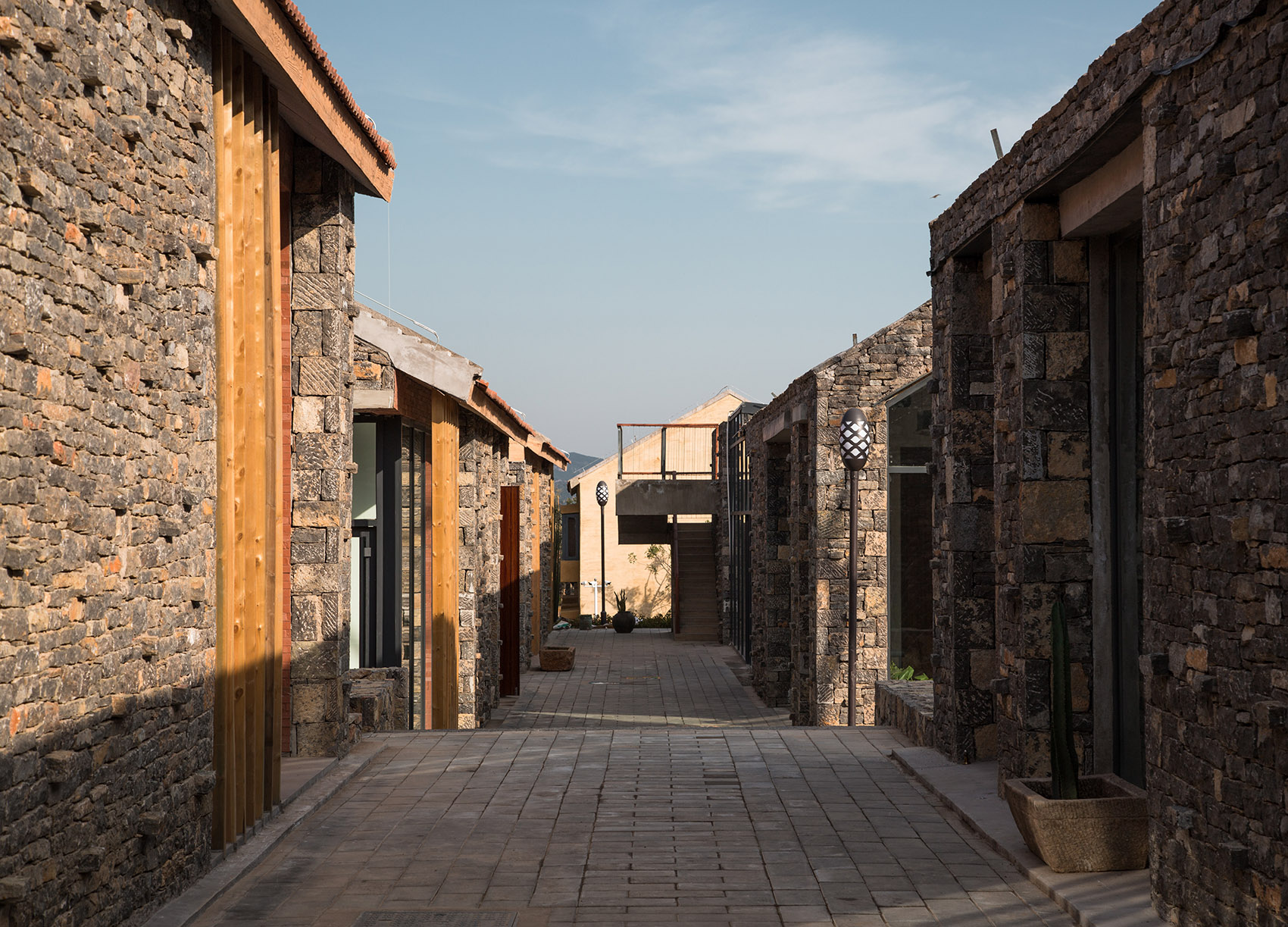
村落西边,面向道路的“门户地带”,是柿子岭村的公共服务中心。作为村子的起点和聚集之处,公共服务中心需要为驻民提供娱乐、交流、学习的空间,具有很强的公共属性。在这组建筑中,为了平衡公共性与地域性,设计将地方原生建筑语言放在当代建筑语境中加以重述,融合地域文化与现代建筑场所精神,从符号、材质、建造等方面进行表达,为建筑赋予空间叙事性。
To the west of the village, facing the “gateway” of the road, is the public service center of Shiziling Village. As the starting point and gathering place of the village, the public service center needs to provide residents with space for entertainment, communication, and learning, and it has strong public attributes. In this group of buildings, in order to balance publicity and regionality, the design puts the local native architectural language in the context of contemporary architecture and repeats it, blending regional culture and the spirit of modern architectural sites, and expressing it in terms of symbols, materials, construction, etc. , To give space narrative to the building.
▼公共服务中心鸟瞰,aerial view of Public Service Center © 张坤

▼公共服务中心,Public Service Center © 张坤
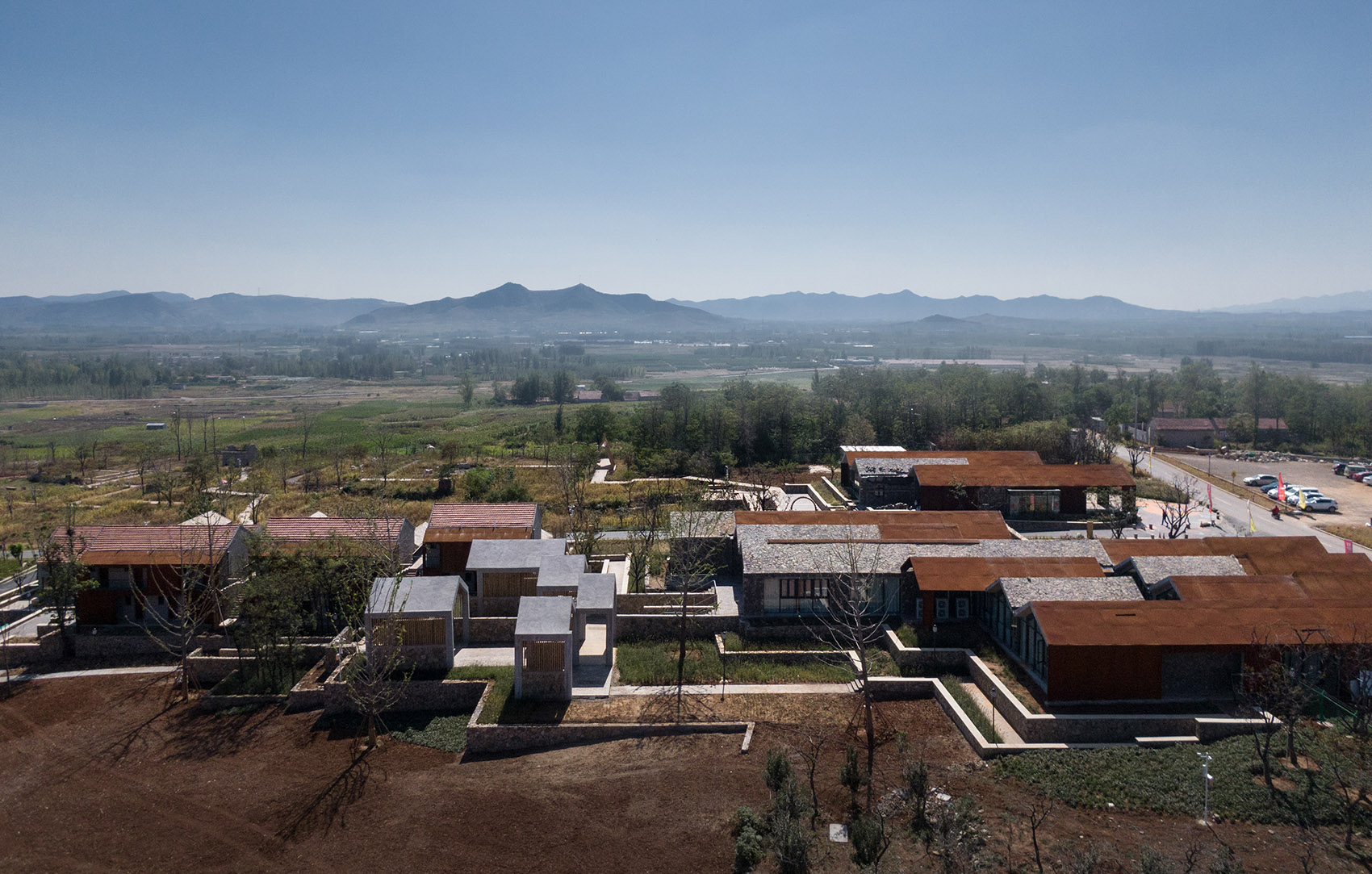
设计师将村落原始的坡屋顶元素提取出来,作为乡村服务中心的形态生成基础。双坡屋顶作为母题,在平面上通过复制、错动、断开,自由而有机地生长成完整、连续而富有动态的折面形式。在这片屋顶下,不仅可以实现大空间的功能设想,还形成了连续坡面的室内空间效果,完成了建筑自外向内的一致性。
▼公共服务中心,Public Service Center © 张坤
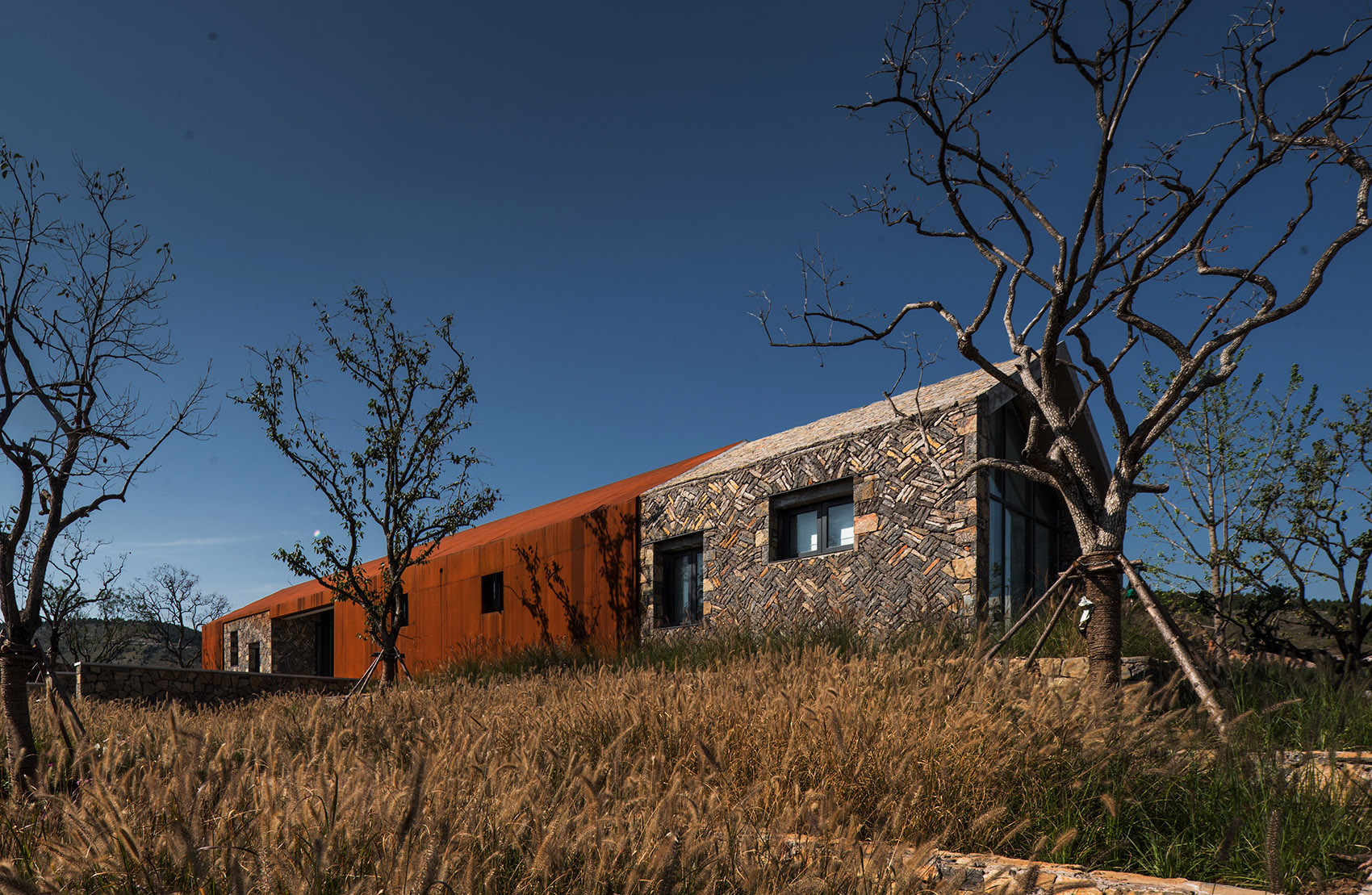
We extracted the original slope roof elements of the village as the basis for the formation of the village service center. Taking the double-sloped roof as a motif, it can be freely and organically grown into a complete, continuous and dynamic folding surface form by copying, shifting and breaking on the plane. Under this roof, not only can the functional assumption of a large space be realized, but also an indoor space effect of continuous slopes is formed, which completes the consistency of the building from outside to inside.
▼公共服务中心入口,entrance of Public Service Center © 张坤

▼屋檐细部,roof details © 张坤

建筑西山墙面向道路,是乡村服务中心的主要出入口。屋顶形式在山墙上的表达由于母题的重复具有强烈的符号感,我们将这种符号语言外延、强化,形成主入口灰空间。在建筑东侧,用同样的手法,通过构筑物的形式将室内空间渗透到田野中,屋面形式的延续,围合界面的开放,将这里营造成为介于建筑与环境之间的特殊空间场所,感受建筑的庇护和自然的环绕。
The west wall of the building faces the road and is the main entrance to the rural service center. The expression of the roof form on the gable wall has a strong symbolic sense due to the repetition of the motif. We extended and strengthened this symbolic language to form the main entrance gray space. On the east side of the building, using the same method, the interior space is penetrated into the field through the form of a structure. The continuation of the roof form and the opening of the enclosed interface will create a special space between the building and the environment Shelter and natural surroundings.
▼景观构筑物,landscape architecture © 张坤
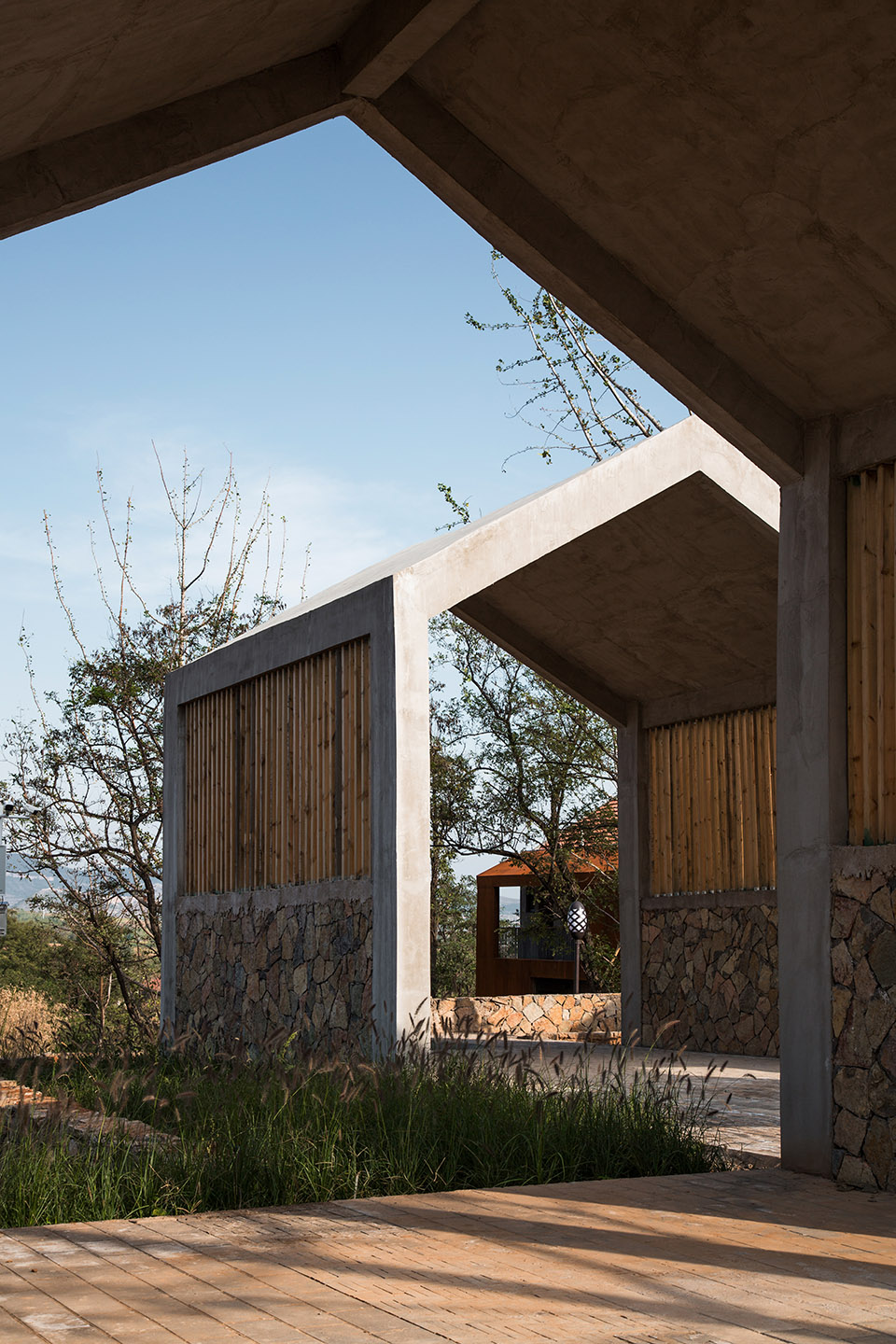
建筑主体采用垒石和耐候钢板作为主要立面材质。垒石是地域材质的表达,以当地特色的砌法,在立面上呈现自然的纹理和质感。深红色耐候钢板隐喻了当地传统建筑的红瓦屋顶。或灰或黄的块石和深红色的耐候钢板呈现了不同质感的粗糙,形成丰富的立面肌理和色彩层次。主体建筑之外,向场地东边延续的空间构筑物则采用了石材、清水混凝土和木材的经典材质组合。灰白色的清水混凝土在场地中透出一种清爽的朴素,混凝土屋顶与石材矮墙之间用原木格栅为屏,至此,可见灰调的“实”、可触木质温润的“虚”、可感无际田野的“空”,三者之间的界面转换带来迷人的光影变化和空间感受。
The main body of the building uses block stones and weathering steel plates as the main facade materials. The block stone is an expression of regional materials. With the local construction method, the natural texture and texture are presented on the facade. The dark red weather-resistant steel plate is used here to express the original red of the village with modern architectural techniques. The gray or yellow block stones and the deep red weathering steel plate show different textures and roughness, forming rich facade texture and color levels. In addition to the main building, the space structure that continues to the east of the site uses a classic combination of stone, clear concrete and wood. The off-white fair-faced concrete reveals a refreshing simplicity in the site. The log grille is used as the screen between the concrete roof and the stone low wall. Feel the “emptiness” of the endless fields, the light and shadow changes and space feeling brought by the interface transition between the three are fascinating.
▼细节,details © 张坤

柿子岭理想村作为整村更新实践项目,相比单体建造更需深入思考乡村的内涵与未来。在朱家林田园综合体的文旅背景下,柿子岭理想村无法避免城市文化和非传统业态的渗透。面对差异性的强烈冲击,设计师在实践中尝试从策划和建造的角度,循序渐进地完成现代文化与传统地方特色的交融。在柿子岭理想村的更新过程中,通过设计的微介入,当地典型的“大院”作为原型生成民宿、逐步打开形成街区、空间整合成为公共建筑,完成了传统元素从保留传承到现代设计语言表达的过程。对于游客而言,自村头到村尾,则是一场始于现代化公共服务场所、游于地域特色空间氛围、终于传统空间形态下生活场景的完整体验。
As a whole village renewal practice project, Shiziling Ideal Village requires more in-depth consideration of the connotation and future of the village than single construction. In the context of Zhujialin’s rural complex, Shiziling Ideal Village cannot avoid the penetration of urban culture and non-traditional formats. Facing the strong impact of difference, the designer tried in practice to gradually integrate modern culture with traditional local characteristics from the perspective of planning and construction. In the renewal process of Shiziling Ideal Village, the design started with minimal intervention, transforming the typical local “yard” from being a prototype into a homestay, to gradually opening to form blocks, and then integrating the space into a public building, completing the traditional elements from preservation to the process of modern expression. For tourists, from the beginning of the village to the end, it is a complete experience that begins in a modern public service place, swims in a regional special space atmosphere, and finally lives in a traditional space form.
项目名称:柿子岭理想村 设计方:华建集团上海建筑设计研究院有限公司Free Studio 公司所在地:上海 项目完成年份:2019年 建筑面积:7600.505㎡ 项目地址:山东省沂南县柿子岭村 委托方:沂南县朱家林田园综合体指挥部 主持建筑师:沈钺 建筑设计:王晔、陈静、孙雨桐 机电设计:殷春蕾、陈艺通、戴鼎立、胡洪 结构设计:李伟、申伟国 室内与景观:上海时代建筑设计有限公司 策划与运营:乡伴旅游文化发展有限公司 撰文:王晔 摄影:张坤
Project Name: Shiziling Ideal Village
Architectural Firm: Institute of Shanghai Architectural Design & Research(Co., Ltd. )-Free Studio
Company location: Shanghai
Completion Year: 2019
Gross Built Area: 7600.505㎡
Project Location: Shiziling Village, Yinan County, Shandong Province Clients: Zhujialin Rural Complex Headquarters, Yinan County
Lead Architects: Shen Yue
Architectural design: Wang Ye, Chen Jing, Sun Yutong
Engineering: Yin Chunlei, Chen Yitong, Dai Dingli, Hu Hong
Structural design: Li Wei, Shen Weiguo
Interior and Landscape: Shanghai Times Architectural Design Institute Co., Ltd.
Planning and operation: Xiangban Tourism Culture Development Co., Ltd.
Written by: Wang Ye
Photography: Zhang Kun
